In my articles and books, I’m always mentioning how Nintendo of America didn’t allow certain types of content in games during the 1990s – things like death, religious content, and stuff like that. The topic comes up often enough that I thought it’d be nice to take an actual look at those policies in detail.
Background
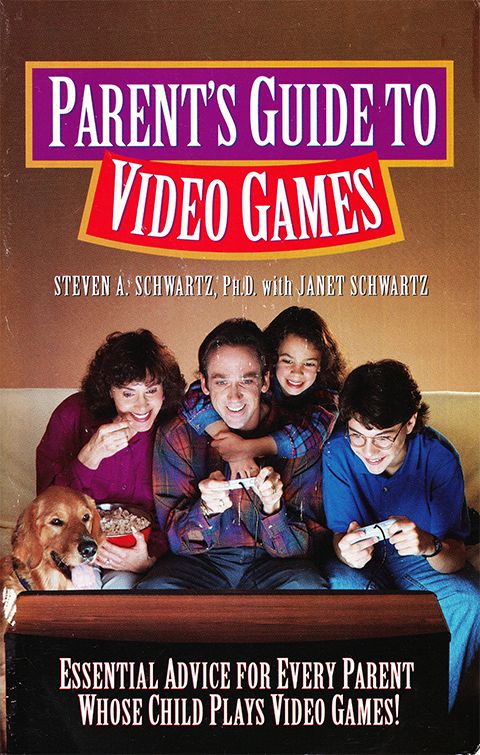
Conveniently for us, the 1994 book Parent’s Guide to Video Games compiled some of these content policies into one place. So although we’ll be looking at Nintendo of America’s policies this time, maybe we’ll look at Sega’s policies in a different article someday. For now, here’s how the authors sum up the situation in 1994:
Let’s consider an analogy. Periodically, we’ll hear on the news that a child has fallen into a well. Although it doesn’t happen often, this can have dire consequences for a child.
If Nintendo were to handle the situation, they might alter all the wells so that none was more than two feet deep. Sega would leave the wells as they found them, but post a conspicuous warning sign on any one that posed a danger to small children.
Indeed, Nintendo’s content policies in the 1990s meant that many games had to abide by strict rules before being published. And since many of the big-name games at the time were coming from Japan, many Japanese games had to be altered during the game localization process.
Official Policies
This was Nintendo of America’s official policy notice around 1994:
Nintendo of America’s priority is to deliver high quality video game entertainment for our customers. When those customers are children, parental involvement in their game playing is recommended. Nintendo is concerned that our products do not contain material that society as a whole deems unacceptable.
Consequently, since 1988 we have consistently tested the content of all games developed for Nintendo systems against our evolving game standards. As our business has matured, we have adapted our guidelines to meet the concerns of the members of our target age group and their parents. Although we realize that definitions of social, cultural and political values are highly subjective, we will continue to provide consumers with entertainment that reflects the acceptable norms of society.
The following Game Content Guidelines are presented for assistance in the development of authorized game paks (i.e., both Nintendo and licensee game paks) by defining the type of content and themes inconsistent with Nintendo’s corporate and marketing philosophy. Although exceptions may be made to preserve the context of a game, Nintendo will not approve games for the NES, Game Boy, or Super NES systems (i.e., audio-visual work, packaging, and instruction manuals) which:
- include sexually suggestive or explicit content including rape and/or nudity;
- contain language or depictions which specifically denigrates members of either sex;
- depict random, gratuitous, and/or excessive violence;
- depict graphic illustration of death;
- depict domestic violence and/or abuse;
- depict excessive force in a sports game beyond what is inherent in actual contact sports;
- reflect ethnic, racial, religious, nationalistic, or sexual stereotypes of language; this includes symbols that are related to any racial, religious, nationalistic, or ethnic group, such as crosses, pentagrams, God, Gods (Roman mythological gods are acceptable), Satan, hell, Buddha;
- use profanity or obscenity in any form or incorporate language or gestures that could be offensive by prevailing public standards and tastes;
- incorporate or encourage the use of illegal drugs, smoking materials, and/or alcohol (Nintendo does not allow a beer or cigarette ad
to be placed on an arena, stadium or playing field wall, or fence in a sports game);- include subliminal political messages or overt political statements.
Examples of Policy-Based Localization Changes
It’s common knowledge that games like Mortal Kombat got tamed down due to Nintendo of America’s content policy at the time:
But as a translator/localizer, I’m personally more interested in how these policies affected Japanese games that were localized into English. So I gathered a handful of old localization changes to see how they fit into the big checklist above.
Sexually Suggestive or Explicit Content
The English localization of Final Fantasy VI adds clothing and other obstructions to cover up exposed skin in places:
 | 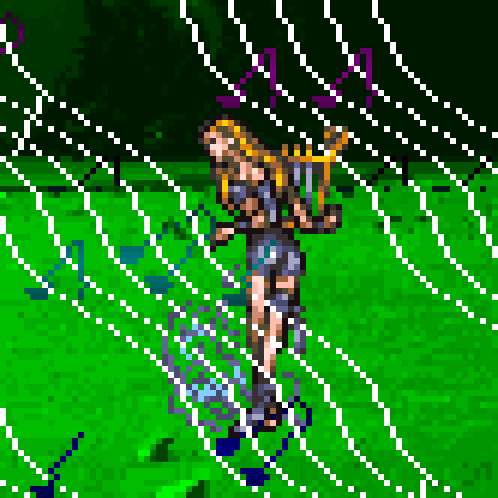 |
| Original Japanese version | Localized version |
Similarly, the English localization of MOTHER 2 puts clothes on Ness when he visits the world within his mind. It’s common for Japanese entertainment to strip characters of everything when they enter mental realms or weird dimensions as a way to indicate that they’re in their rawest, purest, or most vulnerable form:
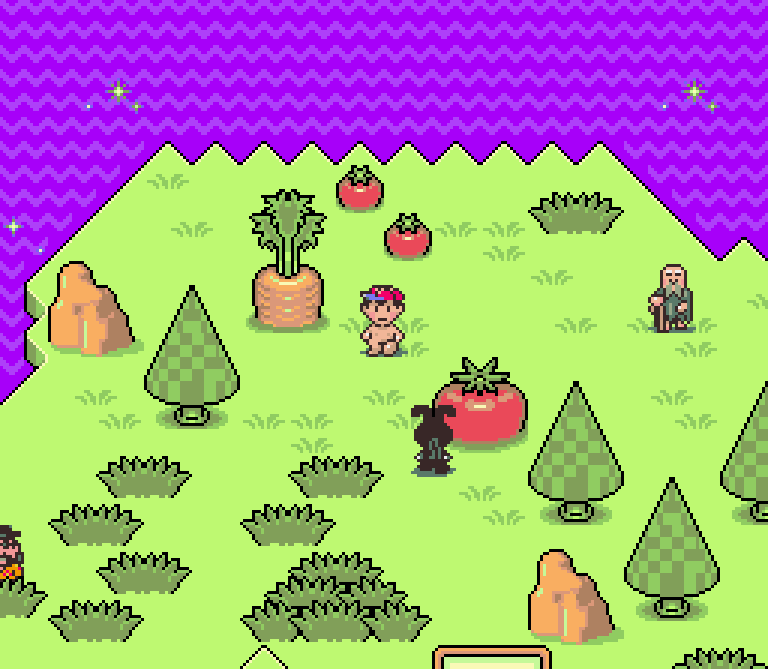 | 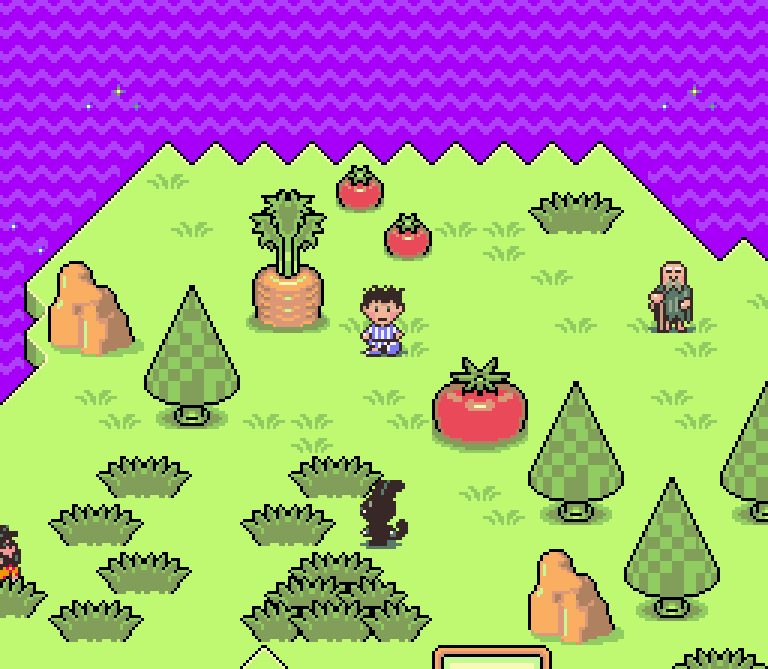 |
| Original Japanese version | Localized version |
During a side quest in Chrono Trigger, Ayla originally talks about nursing babies and breasts. This was rephrased with “leave the nest” to avoid the specific topic:
 |  |
| Original Japanese version | Localized version |
Sexist Content
In the Japanese version of Lufia II, the big casino is full of women dressed in sexy bunny outfits. They were replaced in the English localization with women who dress more modestly:
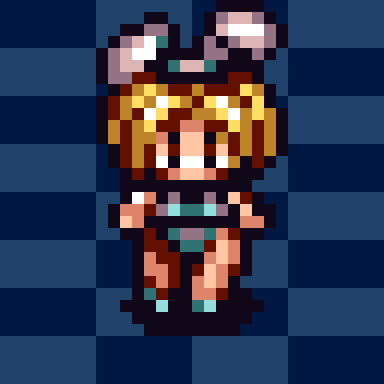 | 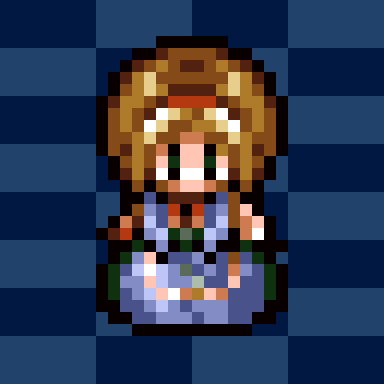 |
| Original Japanese version | Localized version |
Random, Gratuitous, or Excessive Violence
The Super Famicom version of The Combatribes portrayed bad guys covered in blood after being defeated. These graphics were altered and toned down in the English localization, even though the core gameplay is still about violence and physical assault.
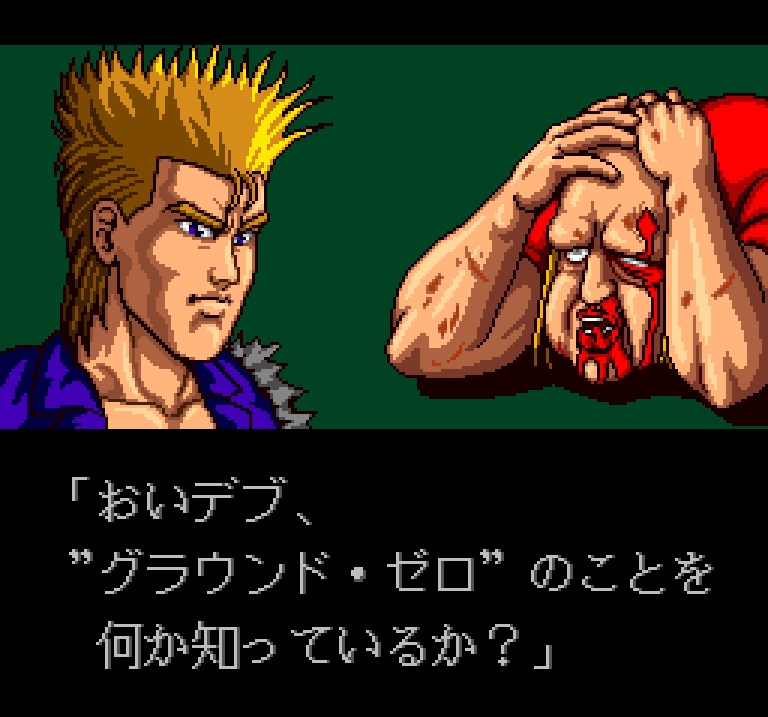 | 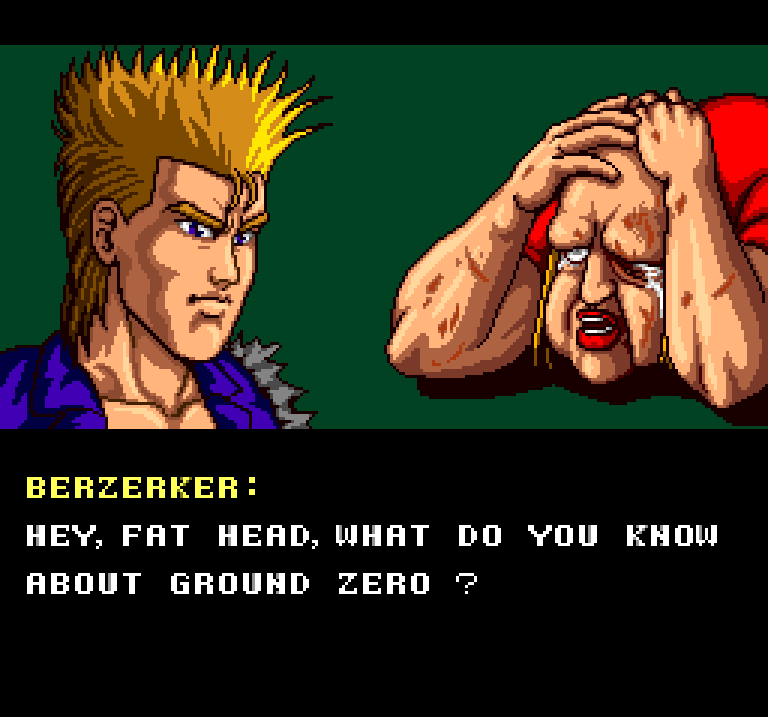 |
| Original Japanese version | Localized version |
Some of the depictions of violence in Final Fight were marginally toned down during the localization process. For example, blood graphics were replaced with cartoon-like impact graphics:
 | 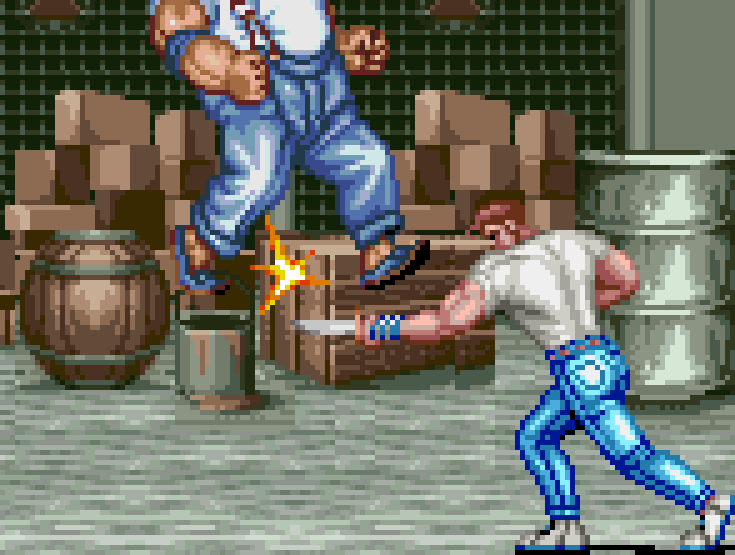 |
| Original Japanese version | Localized version |
Graphic Illustration of Death
I’m not sure if any localized games ever depicted anything that fits this category. The only thing that comes to mind at the moment is when Celes attempts suicide in the Japanese version of Final Fantasy VI by throwing herself off a cliff. She still jumps off the cliff in the localized version, but all the text before it was rewritten to reframe the jump as a nice way for Celes to “perk up” after feeling sad:
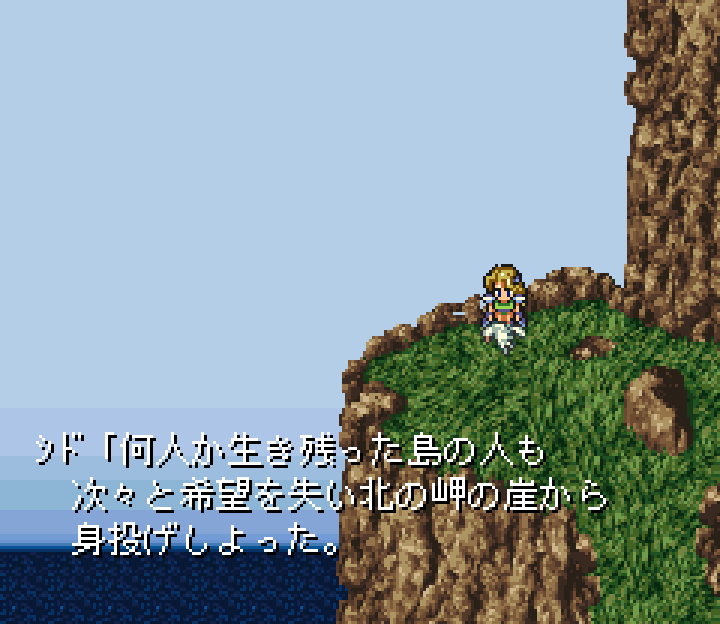 | 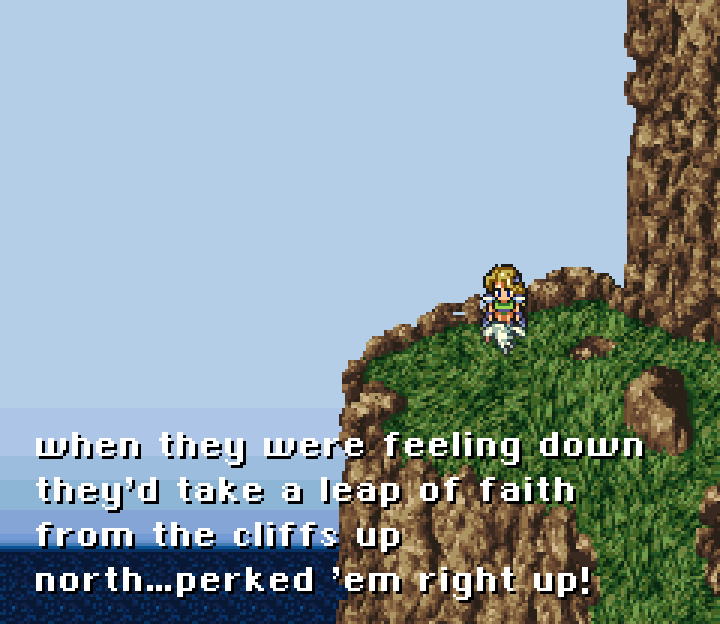 |
| Original Japanese version | Localized version |
Domestic Violence
The only examples of domestic violence changes that come to mind right now are from MOTHER 2/EarthBound. There are several examples, but one early one includes Pokey’s mention of “getting spanked/paddled 100 times” being changed to “I’m gonna get it”:
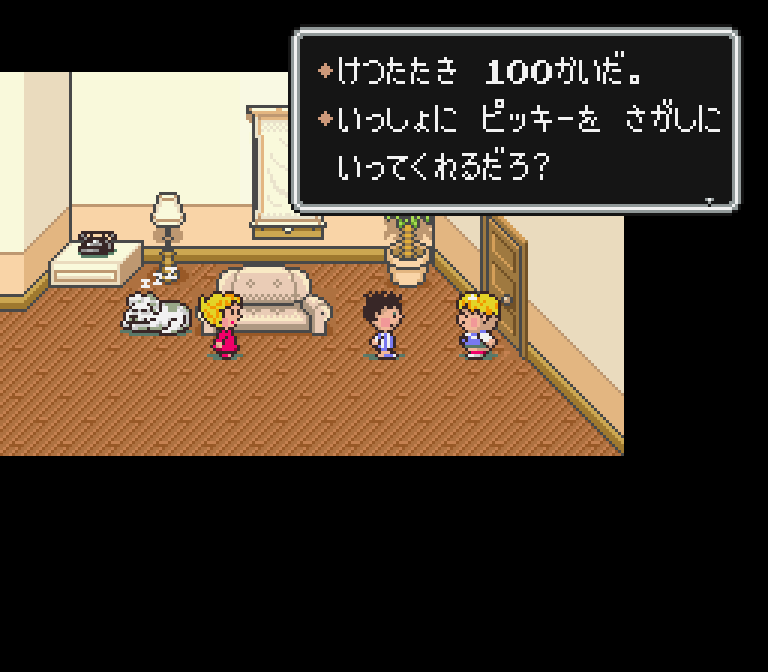 | 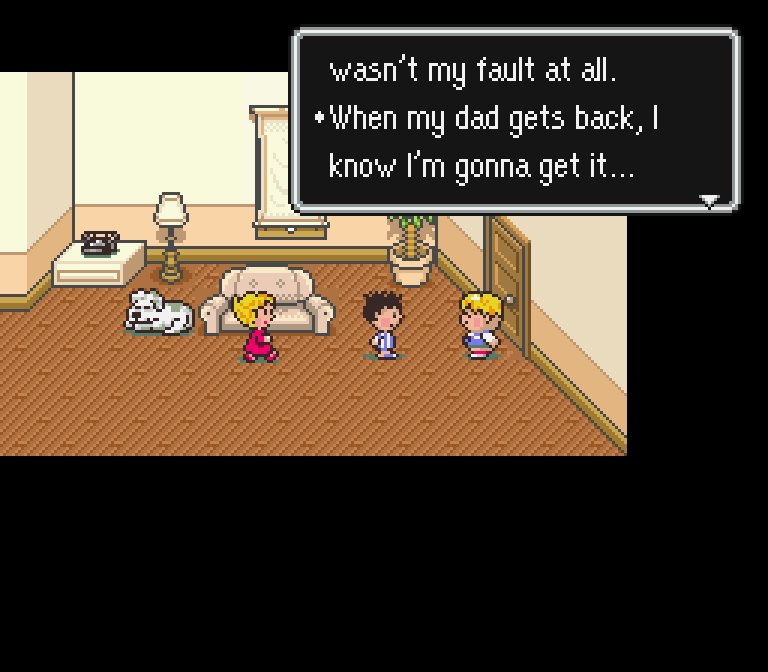 |
| Original Japanese version | Localized version |
Shortly after, Pokey and his brother do get punished by their father, but the depiction of the punishment changed in the localization. The off-screen sound effect was changed from heavy pounding to a cartoon-like angry sound:
After getting punished, Pokey mentions that his butt hurts in Japanese. This was changed in the localization, so he now says he “gets no dessert for the rest of the decade”:
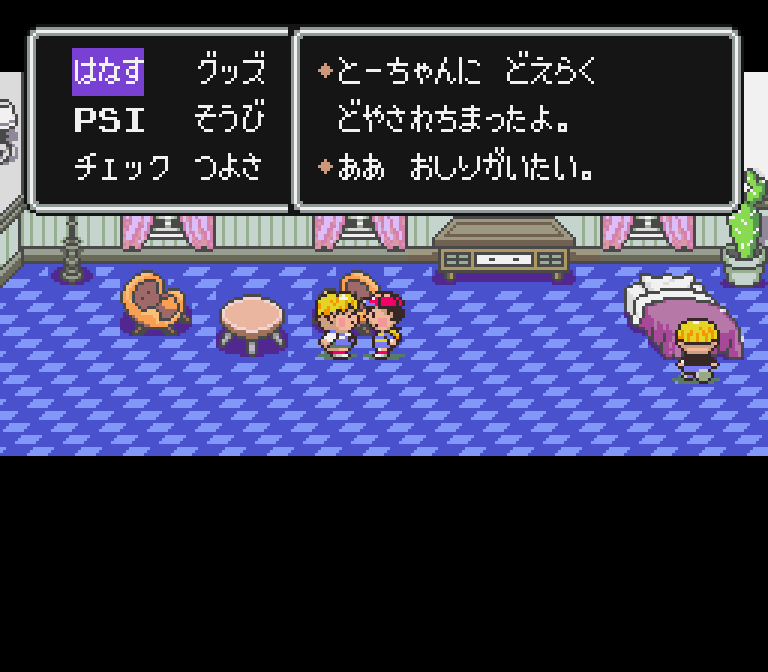 | 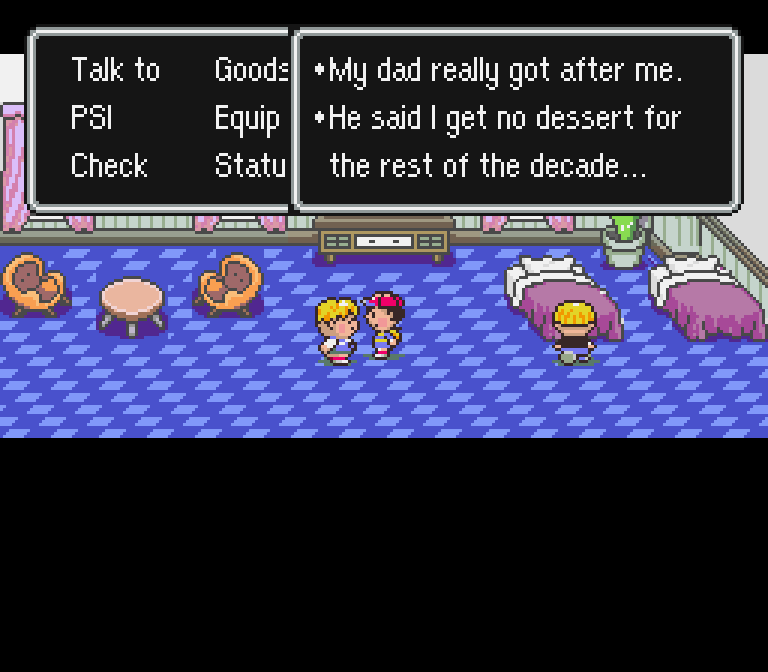 |
| Original Japanese version | Localized version |
Not too many Nintendo games had scenes involving modern domestic situations, so I don’t know if any other games underwent similar localization changes during the 1990s. If you know of any others, let me know.
Excessive Force in a Sports Game
I’m not sure if this category ever came into play when a 1990s game was localized into Japanese for Nintendo consoles. I’m not a sports gamer in general, so if anyone out there has more info, let me know!
Ethnic, Racial, Religious, Nationalistic, or Sexual Stereotypes
It turns out Final Fight underwent lots of policy-related changes during the localization process. In this case, some enemies had their dark skin lightened, presumably to avoid backlash against violence toward specific races:
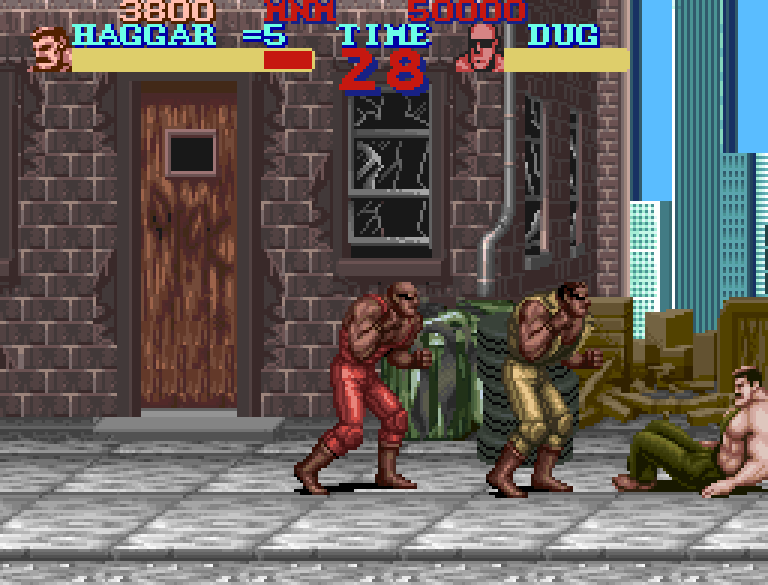 | 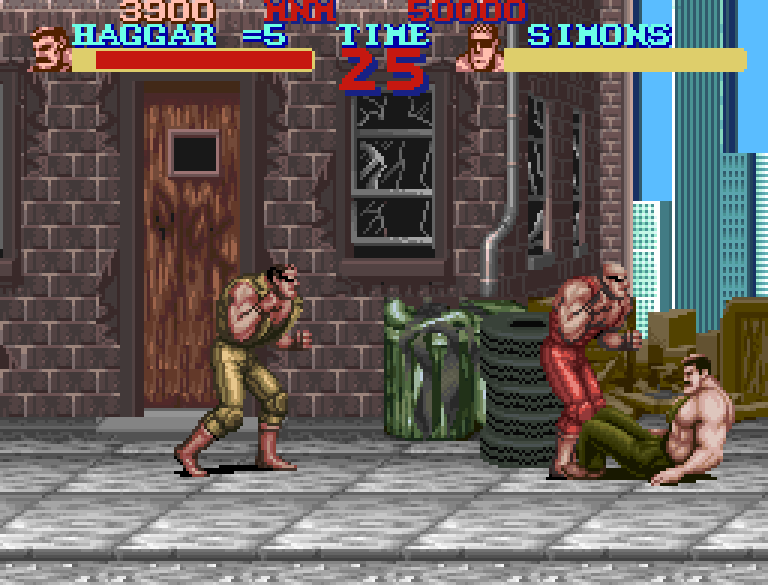 |
| Original Japanese version | Localized version |
In the second generation of Pokémon games, Jynx was changed from a black-colored Pokémon into a purple-colored Pokémon. This was done after Jynx’s initial appearance caused some controversy outside of Japan.
 | 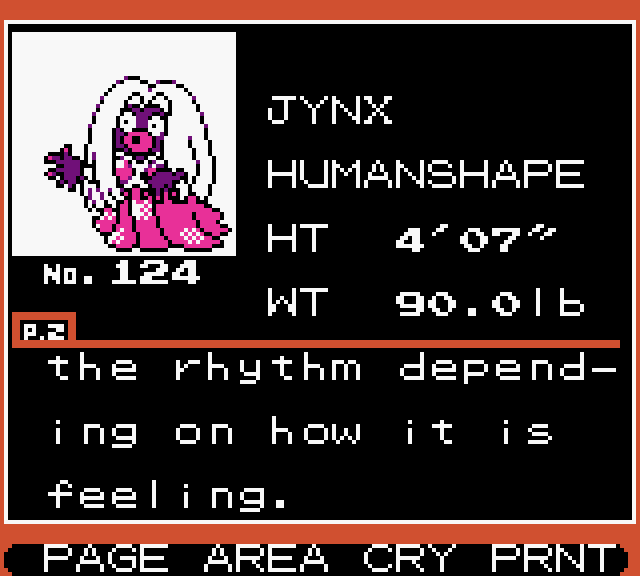 |
| Original Japanese version | Localized version |
In the original Final Fantasy game, you had to revive fallen party members by visiting a church. This was changed into a “clinic” in the localized release. The building’s appearance was changed on the outside, and the priest on the inside was changed into a generic, non-religious character. The associated text was changed as well – even the text about reviving a fallen character’s soul was changed:
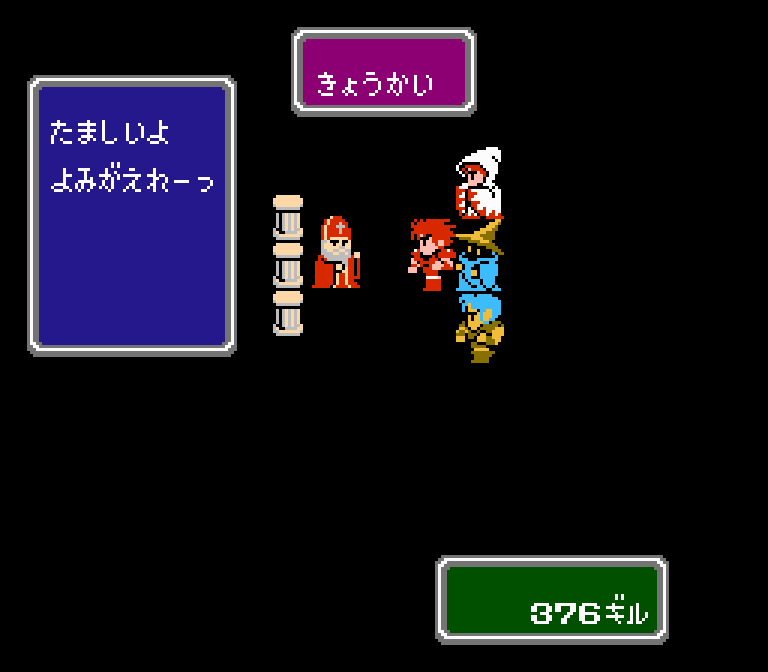 | 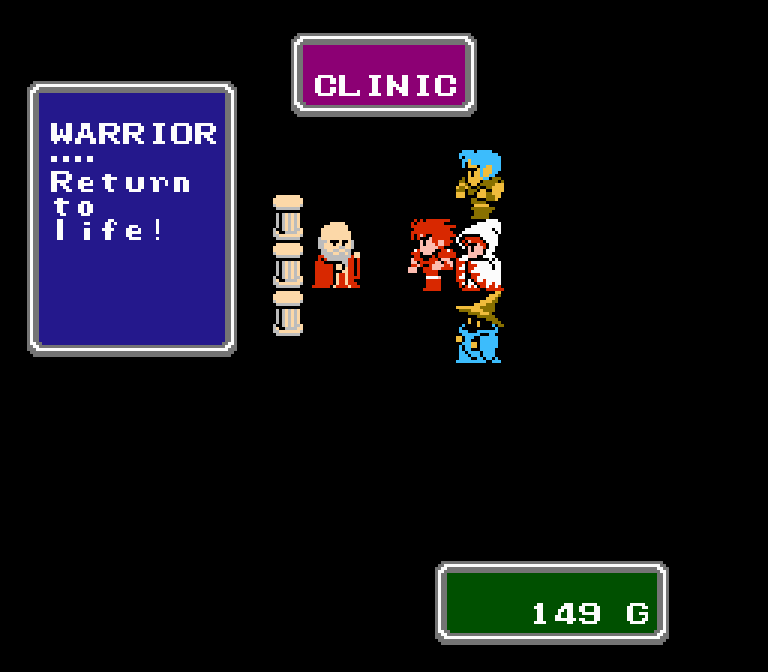 |
| Original Japanese version | Localized version |
In the Japanese version of Actraiser, you’re God and you have to fight Satan. In the English localization, you’re “The Master” and you have to fight “Tanzra”:
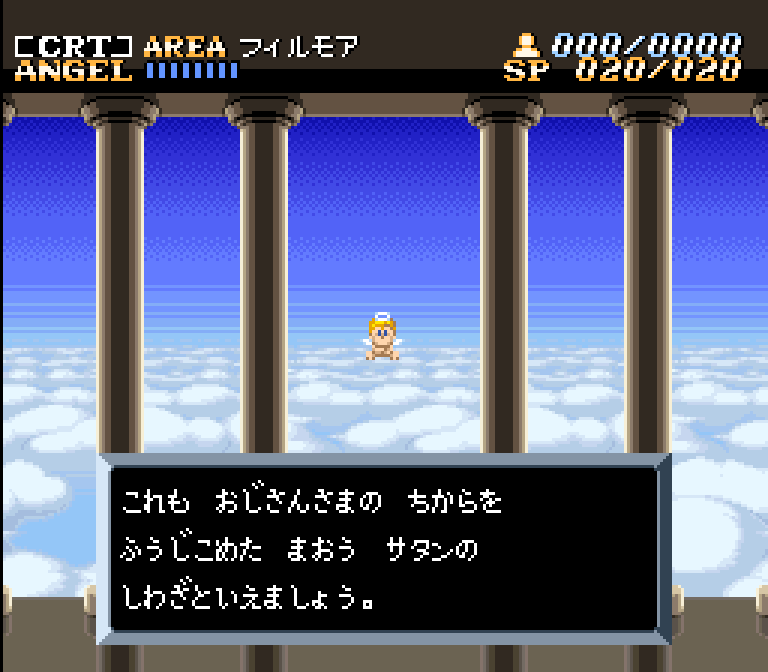 | 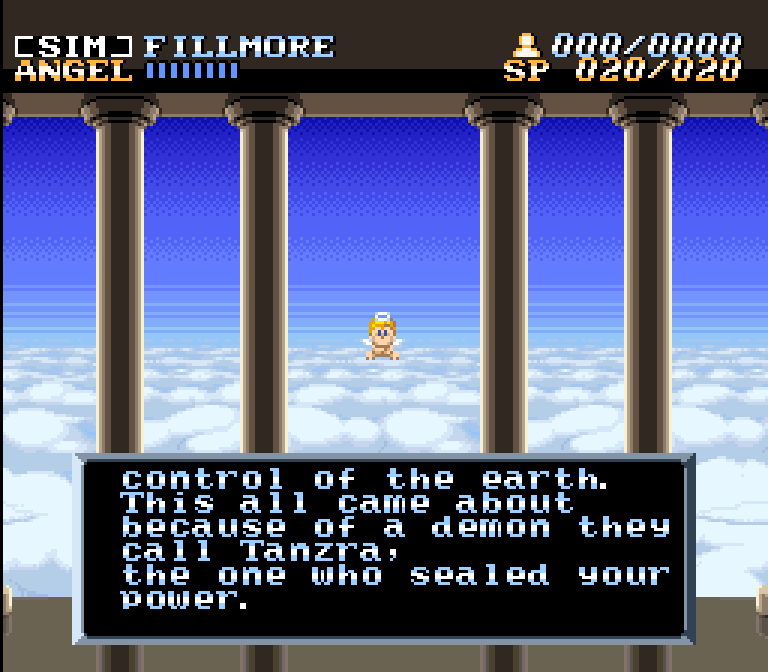 |
| Original Japanese version | Localized version |
Profanity, Obscenities, or Offensive Gestures
In the Japanese version of Super Mario RPG, Bowser does a gesture with his arms after winning a battle. It’s a common, positive gesture seen in Japanese entertainment (example 1, example 2), but it’s considered rude in some places outside of Japan, so Bowser’s gesture was changed for the English release:
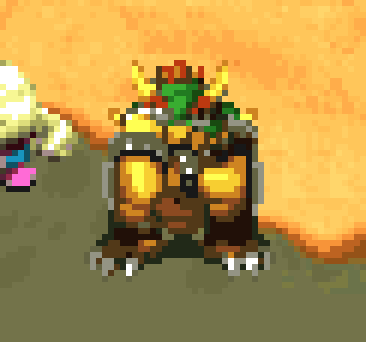 | 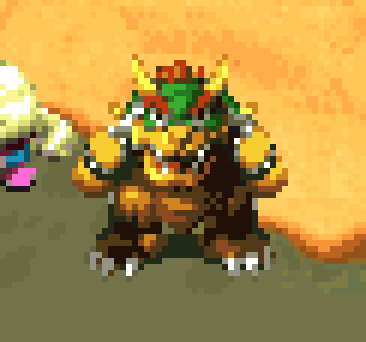 |
| Original Japanese version | Localized version |
Illegal Drugs, Smoking Materials, or Alcohol
The Japanese version of Super Mario Kart shows Bowser drinking a bunch of celebratory champagne after he wins a race circuit. Nintendo of America altered this for the localized version:
 | 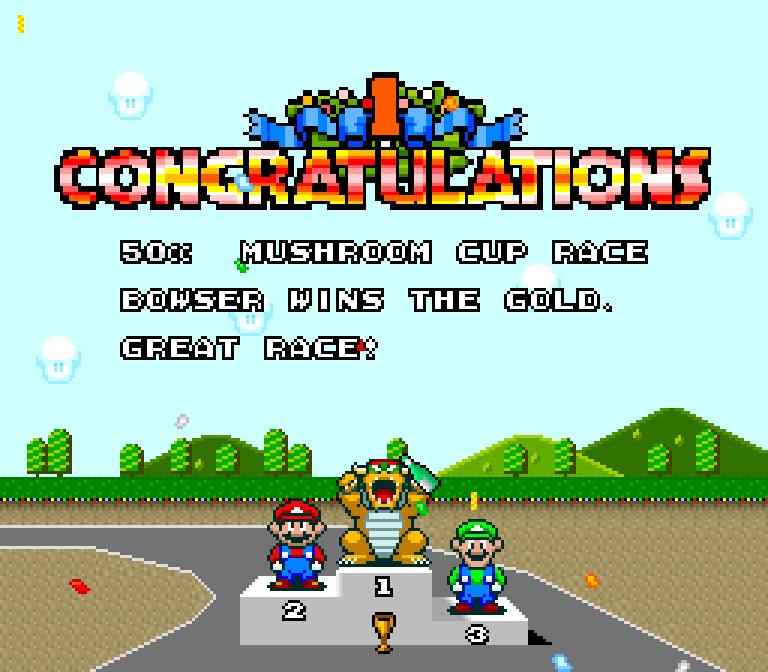 |
| Original Japanese version | Localized version |
There’s a good amount of alcohol-related content in MOTHER 2, so when it was localized into English as EarthBound it was all replaced with coffee-related content. Even the bars became cafes:
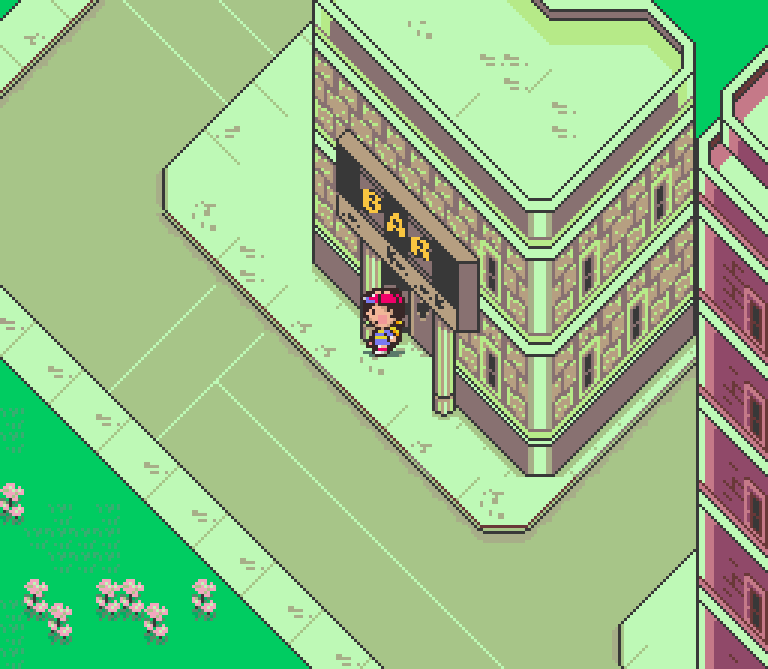 | 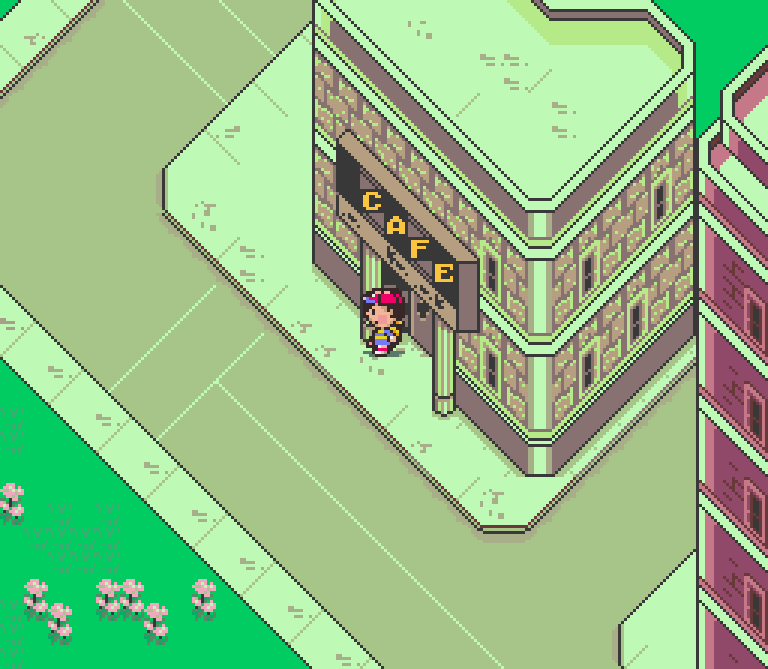 |
| Original Japanese version | Localized version |
In Tecmo’s Secret of the Stars, the original Japanese version has a town called “Drunkards” that’s full of alcohol-related stuff, including bars. For the localization, the town was renamed “Sleepers” and everyone now relies on coffee to get through the day. Naturally, the bars are now coffee shops, complete with newly drawn signs:
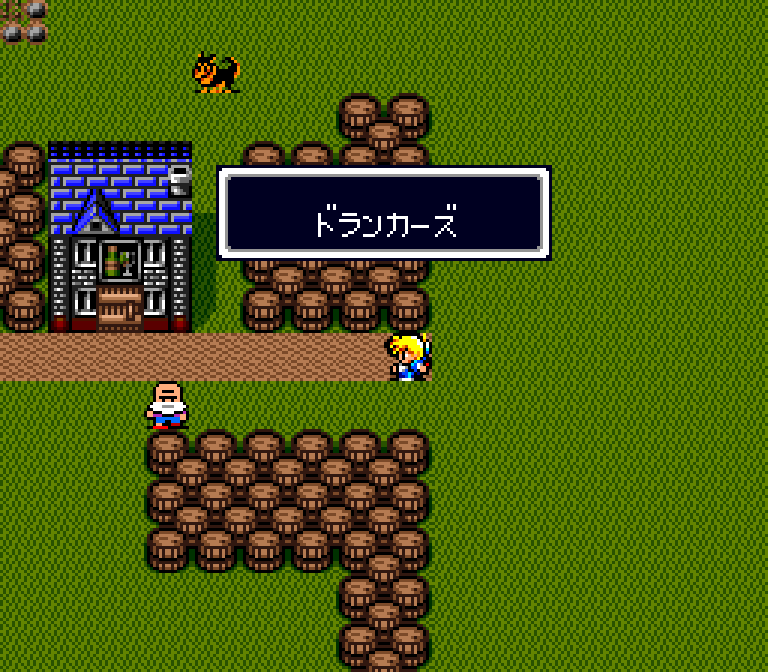 | 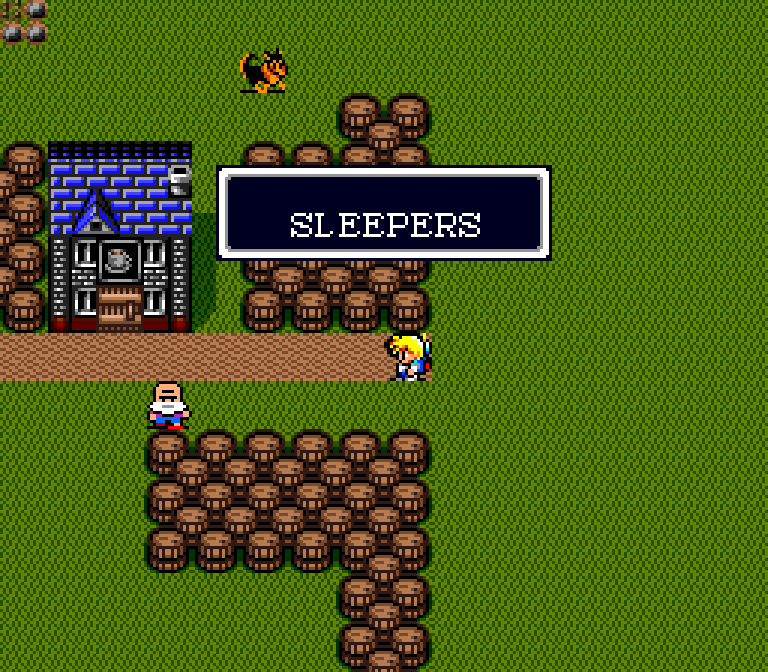 |
| Original Japanese version | Localized version |
In the original Japanese Pokémon games, a drunk guy blocks the path early in the story. In the localized versions, he’s just an old guy who really loves coffee:
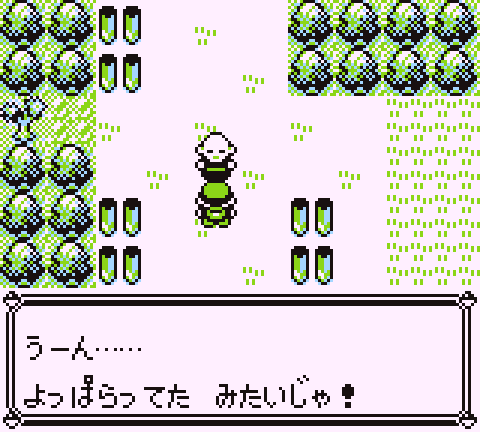 | 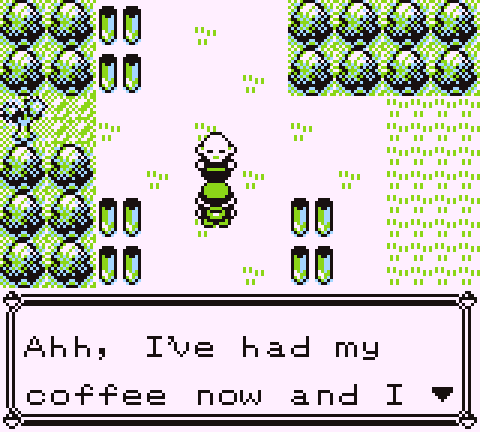 |
| Original Japanese version | Localized version |
In the Japanese version of Final Fantasy Legend II, one part of the story revolves around opium and opium smugglers. All of these opium references were replaced with bananas in the English localization:
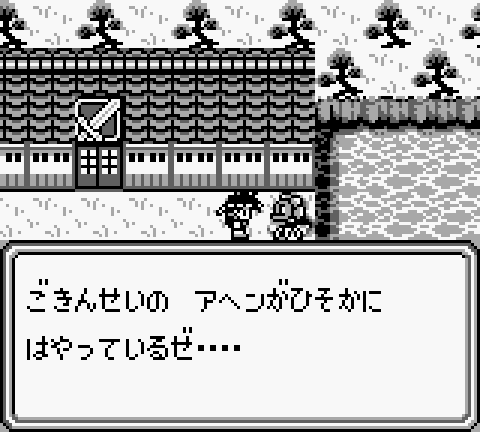 | 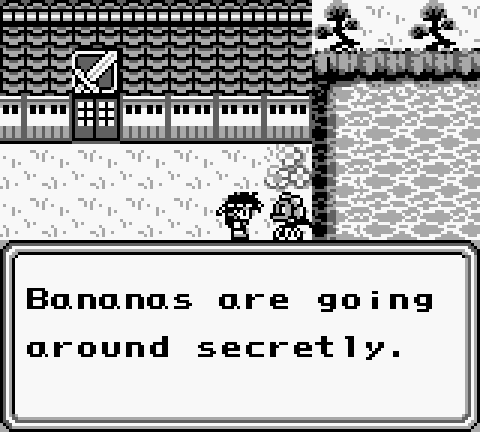 |
| Original Japanese version | Localized version |
Subliminal Political Messages or Overt Political Statements
As far as I know, there aren’t many examples of this sort of change. The only two I can think of at the moment are from MOTHER 2/EarthBound, and even then they kind of overlap with some previous policy rules.
First, the cultists in Happy Happy Village were given a graphical makeover for the English localization to avoid comparisons with the Ku Klux Klan:
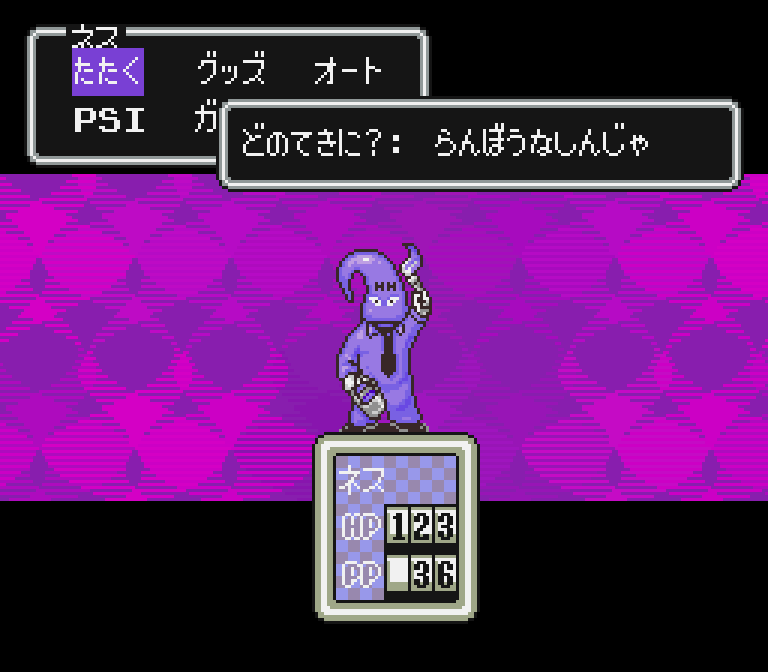 | 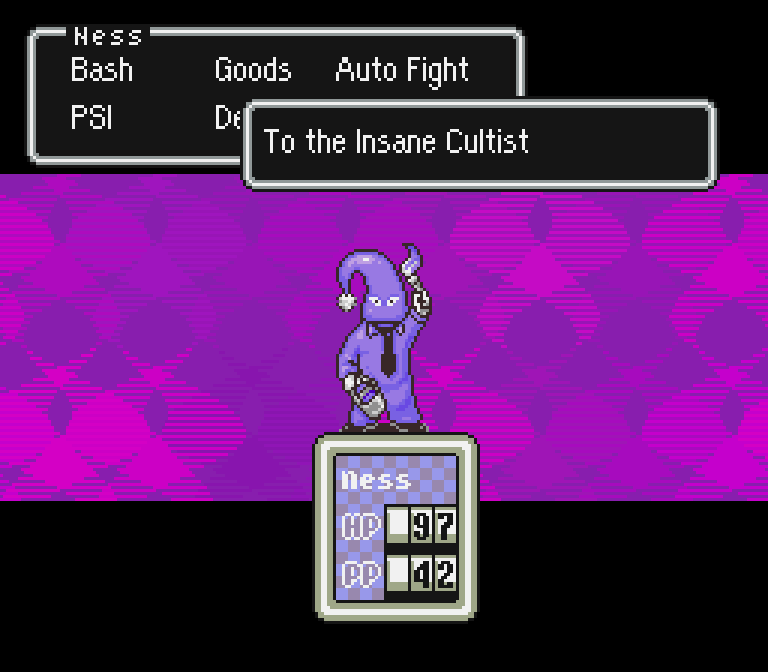 |
| Original Japanese version | Localized version |
The town of “Threek” was renamed “Threed” for the English localization too. The reason baffled fans for years, until it was revealed that the localization team realized “Threek” could be read as “Three K”, or “KKK” – another coincidental connection with the Ku Klux Klan.
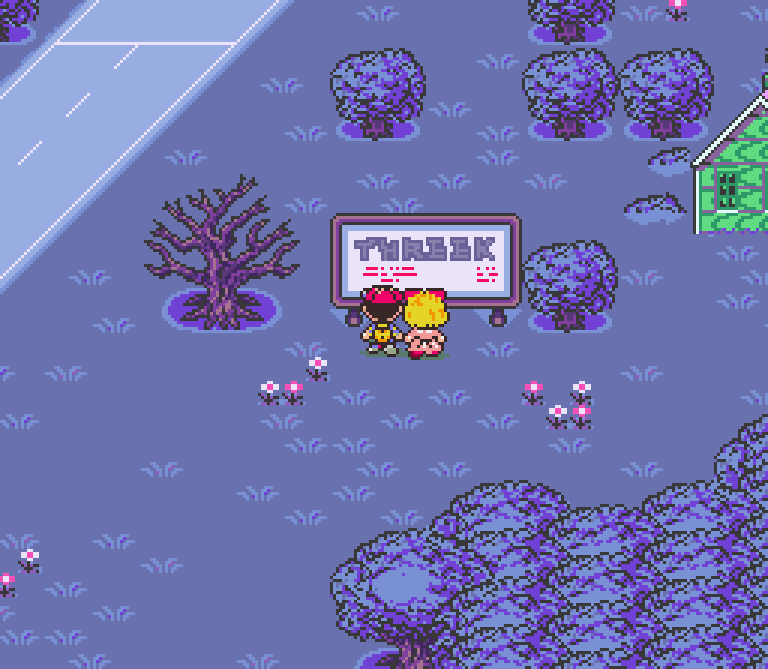 |  |
| Original Japanese version | Localized version |
Publisher Concerns
Many of the games listed above were made or published by Nintendo of America, but third parties also had to abide by Nintendo of America’s policies. If a third party company failed to meet the content guidelines, they would have to make more changes and resubmit the game for approval. This would result in costly delays.
As an actual example, the “Holy” spell in Final Fantasy VI wound up getting renamed as “Pearl” in the English localization, due to the concern that it might run afoul of NOA’s religious content policy.
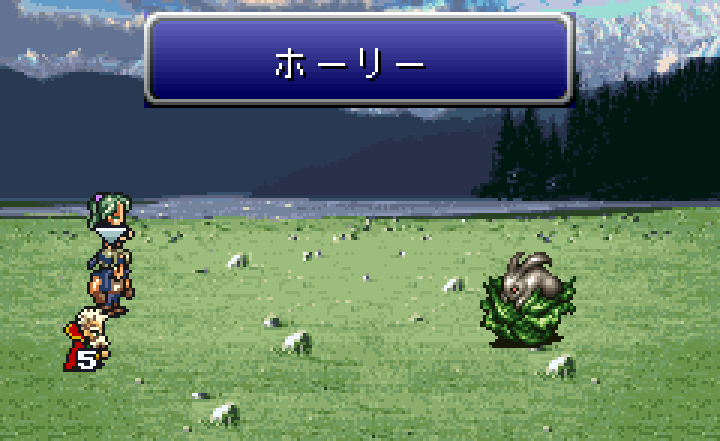 | 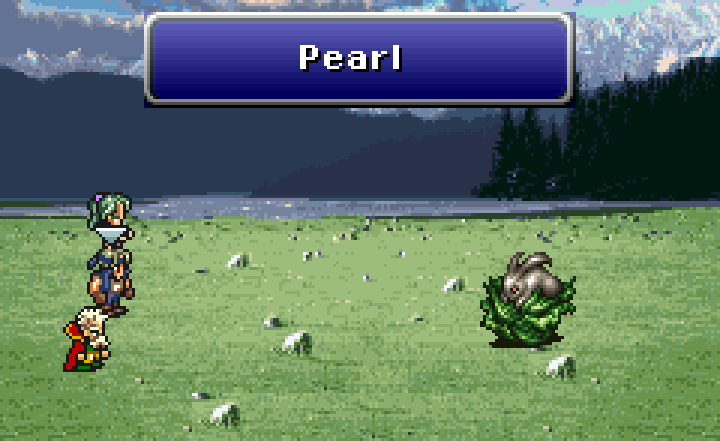 |
| Original Japanese version | Localized version |
The head localizer explained the decision in an interview a decade later:
I mean, Holy and Pearl, obviously there wouldn’t be an issue there. I think that was obviously just the word Holy and just trying to avoid being dinged by Nintendo. Any time you submitted a game to Nintendo you had to take the entire screen text, which for Final Fantasy was 50 or 60 hours of having one of your testers do that for you. Then you had to submit the print out, the entire screen text, the ROMs and do all that stuff and give it to them and they’d spend time going through it. If you had something like that, that stopped the submission you were in trouble. It was very expensive and you could miss your deadline to ship.
A lot of companies just decided to err on the safe side, which is probably unfortunate but just to strip out as much as they could in advance just to reduce the time to market.
In short, third party companies sometimes altered more content during the localization process than necessary, just to be safe. These excessive changes stemmed from internal business decisions.
Summary
We’ve taken a brief look at Nintendo of America’s old content policies and how they affected specific game localizations. Nintendo has changed and evolved since the 1990s, so many these policies are no longer in place. Still, some of the localization changes made during this era became iconic and even laid the foundation for later game localizations. So I’m glad to finally know more about the details that shaped video game localization in the 1990s.
There are many more examples than what I’ve listed above, so if you can think of any other big or notable additions, let me know. I’d like to create big, dedicated gallery pages for specific categories or specific games sometime. I think they’d be lots of fun to build up over time and browse through!
Also, if you enjoyed this article, check out this classic article about NOA's content policies!


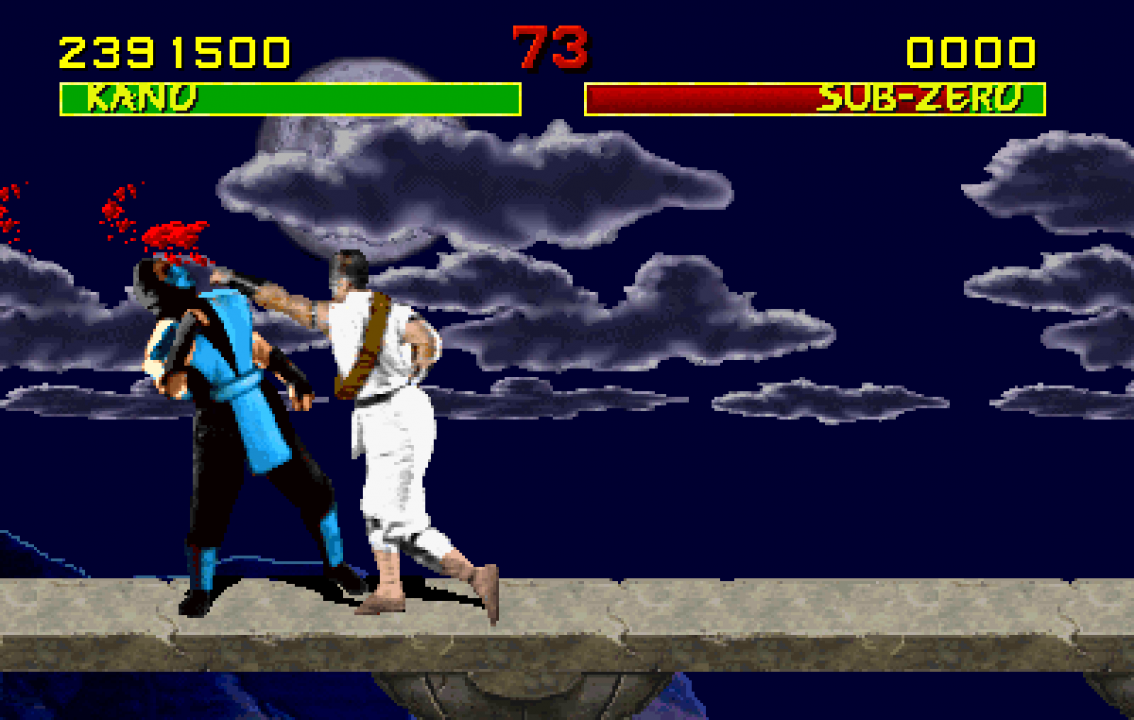
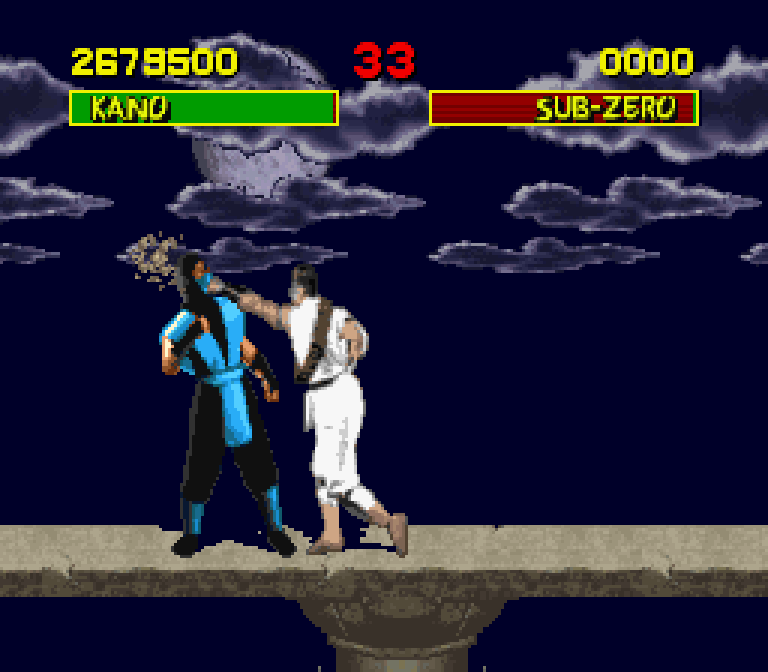

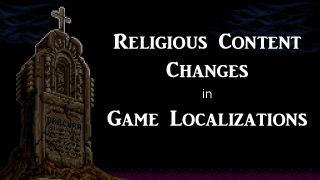
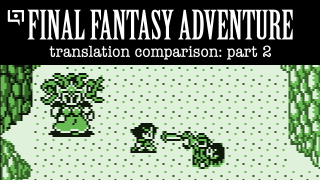
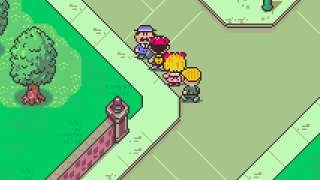
Coffee sure is an easy G-rated replacement for another “grown-up drink”, huh?
Caffeine IS the most widely abused drug in the world.
The first Grandia even did the coffee instead of alcohol thing too and that wasn’t even on a Nintendo system.
Captain Novolin Night would have been a surreal experience.
I mentioned how Golgo 13: Top Secret Episode somehow evaded Nintendo’s policies in a previous post. Another one is Shadowgate. A number of death scenes are graphic by 1980’s Nintendo standards, particularly when killing the Cyclops. The text describes your character thrusting your sword into the cyclops’ and then blood spilling onto the ground. Additionally your character utters the word “death” during a battlecry.
Clear smoking references slipped through at least two games: the aforementioned Golgo 13 and Metal Gear.
A game to look at for “excessive force in a sports game” is NFL Blitz, though this came out for the Nintendo 64, after Nintendo loosened its policies. I have no experience with the N64 port but can say the original arcade version of the game has mechanics for late hits and other unsportsmanlike conduct. Perhaps ironically, late hits and other acts of aggression were removed from the later entries, not by Nintendo but due to complaints from the NFL.
Another Final Fight censorship was replacing the female fighters with skinny, effeminate males. I always thought this change was amusing because instead of “denigrating” women now they’re “denigrating” gay stereotypes.
I think that just illustrates how the policy got tightened up over time. The article says that Nintendo started focusing on this kind of thing in 1988. Golgo 13 (1988) and Shadowgate (1989) might have already passed review before policies were finalized, or they might have been among the games that made them think their policies might have needed further refinement.
-With Final Fight some of the villains that you beat-up are technically transvestites or transgender characters. Or this was the argument that Capcom made, when Nintendo insisted the the female villains be removed. From what I recall, Nintendo banned homosexuality in games until 1999/2000, and generally treated transgenderism as something akin to homosexuality. Nintendo did not want ‘violence against women’ in Final Fight and they apparently also did not want transsexuals. Oddly enough, the female villains in Final Fight were restored for the Sega CD port.
This article on how it ended is likely worth a mention when we’re on the subject
http://articles.latimes.com/1994-09-09/business/fi-36631_1_mortal-kombat-ii
Here’s some stuff you missed from Nintendo’s censorship:
Sexually Suggestive or Explicit Content:
* Castlevania III and Super Castlevania IV had nude statues covered up with robes.
* Sodom’s name in Final Fight and Street Fighter Alpha 2’s name was changed to Katana, as the original name could refer to acts of sodomy (aka butt stuff).
* Abadox’s naked princess was given a pair of clothes.
* Dragon Warrior’s puff-puffs were changed to either a massage, fortune telling or selling tomatoes.
* Both localizations of Dragon Ball: Shenlong no Nazo (The English Dragon Power and the French Dragon Ball) changed Muten Roshi’s pervertedness with an addiction to sandwiches.
Sexist Content:
* The Playboy bunnies and one of Alena’s opponents in Dragon Warrior IV had their ears and tails removed.
Excessive Violence and Graphic Illustration of Death:
* Death gets decapitated when you beat him in Castlevania: Dracula X, but is set on fire in the English version. Simularly, Richter’s death is bloody in Japanese, but the blood was turned white in English.
* It’s likely that Capcom’s Sweet Home wasn’t localized in English due to the graphic death scenes when a party member dies. See here: https://www.youtube.com/watch?v=TvliWq1XKcI
* Oddly, despite the infamous violence of the source material, enemies still explode when killed in the NES Fist of the North Star game.
Racial Stereotypes:
* Breath of Fire’s Karn had his sprites changed since his design resembled the blackface stereotype. Similar design changes happened to Zelda’s Skull Kids, Doki Doki Panic/Mario 2’s turtle shells,
* Vodka Drunkenski had his name changed to Soda Popinski for the release of Mike Tyson’s Punch Out in all territories.
Religious Symbolism
* Games such as Castlevania IV, Super Ghouls and Ghosts, Ducktales and Dragon Warrior II had crosses on tombstones removed or redesigned.
* In instruction manuals for Castlevania games, the crosses were referred to as “boomerangs”.
* Megaman’s Yellow Devil was renamed into the “Rock Monster”
Political Messages:
* The Japanese version of Bionic Commando’s plot involved Neo-Nazis resurrecting Hitler. This was changed into “the Badds” ressurecting “Master D.”. However, not only was Hitler’s appearance unchanged, but he says “damn fools” and has his head explode!
Nice, thanks for this – I didn’t know about a bunch of these!
And yeah, I almost used a number of these but some of them were released in the 80s, so I skipped over them for the purposes of the article. I also wasn’t 100% sure on how Duck Tales was handled, like if it was designed with one audience in mind and then released for another, so I left it out too. It was one of the first ones to come to mind actually.
DuckTales had a number of revisions done from the beta due to a number of inaccuracies on the part of Japan. The only “offensive” thing that had to go was the crosses on the coffins in Transylvania (and the Japanese version does not retain them so there are no differences between releases). Everything else was changed to reflect accuracy to the source material.
For example the healing item was originally hamburgers, which is a reference to Burger Beagle’s appetite. However, this was changed because the cartoon established ice cream is Scrooge’s favorite food and would make more contextual sense as a healing item. Another is Launchpad calling Scrooge “Uncle Scrooge” (which is just plain stupid), which was changed to “Mr. McD” like he calls him in the show.
Oddly enough, although Launchpad does refer to Scrooge as “Mr. McD” in the retail version of the first Ducktales game, he reverts to using “Uncle Scrooge” in Ducktales 2 (same goes for Gyro)
I’ve been playing Ducktales 2 lately (I hadn’t even known it existed until about a week ago) and I noticed that.
Yeah, I noticed that on the Disney Afternoon Collection. You’d think they have learned to watch for the goof again.
That might be just Disney’s mandates. They made life hard for Kemko too (characters should bounce offscreen in a certain way when “defeated”, and only certain weapons like cards, marbles or water balloons were allowed).
That said I think there may need to be more updates and follow ups to this article.
– The ways Nintendo of America changed their policies over time: loosening graphical content guidelines in response to Mortal Kombat 2 backlash (that made Sega look less censorious and caused an actual sale dip), Breath of Fire 2 (first time with a religious storyline), Codename Viper and another NES localization (allowed drug references in an anti-drug context to win the media and government’s good graces), not giving any care anymore about excessive profanity in Ogre Battle 64 (the kind that would make a movie M rated, that was in response to Sony marketing their translations in a certain “cool”, “uncensored” way, and in some cases like FF7 injecting new profanity), cultural sensibility actually increasing (after allowing sombrero Mario and Cowboy Kid in the nineties, shy guys in Mario Party GBA and a character class in Bravely Second have feather head gear removed for localizations), what qualifies as “sexist content” changing over time (allowed then covered then allowed again recently), stance about alcohol (the European Nintendo-published Story of Seasons, and at the request of NoA for Fire Emblem Echoes, all such items were cut and not out of rating concerns…)
– Lesser known, but equivalent semi-official guidelines used by Nintendo of Japan (NCL), Sega of America vs Sega of Europe, and Sony Computer Entertainment in Japan and America. To elaborate:
• Nintendo of Japan (nineties) had a strong aversion to sexual content (nudity, sexual acts, profanity) that didn’t just cover explicit depictions but even text (where publishers on NEC’s PC-Engine and Sega’s Saturn could get away with a textual sum up of the act, and some on-screen boob checking, Nintendo had a zero tolerance policy and some french article even implies it had a publisher blacklist accordingly). It can be seen in SNES ports of PC-98 games in action (Brandish, Dragon Knight IV, Super V.G. …), and I think “Game Over” has a quote from Yamauchi about this policy in the context of NES bootleg with sexual content. A notable exception was Vivrid Dolls on the sub-licensed SETA’s N64 arcade hardware, that was a softcore porn game. Nintendo is a notable exception in how compared to NEC (PC-FX), Philips (CD-i), Sega (Saturn, shortly), and Sony (PSP UMDs, PS Vita), they never allowed actual pornography even when their hardware had a hard time selling.
• Sega of America (Genesis) – cut religious content (crosses, and all references to a god or bible quotes, be it graphics, text or even map layouts. But just in the US version. The European port was retranslated and much closer in all aspects to the JP version. Also redrawn occult pentagrams here and there like in Lunar), covered up sexual clothes (Streets of Rage, changed some text about panties and pervert priests in the Shining series, removed enemies in Phantasy Star IV), removed blood… They were pretty close to Nintendo’s policies except for its more extreme ones (the never say die rule never happened much on Sega’s side). One very interesting observation about Sega of Europe: their localizations of Sega PICO games removed all gambling references.
• Sony – had guidelines about sexual content less strict than Nintendo but more than Sega or Microsoft. They were enforced quite often (Policenauts for example, or some sexual “jokes” added by Working Designs to Alundra that caused it to fail cert), and much like Nintendo’s blanket rule against negative PR (the no political satire rule + content that harms Nintendo’s image) they had a general rule of nothing that harms Sony’s hardware’s image. Console cameos on PS systems have the most strict guidelines as well. They had a while ago a version of their guidelines on an indies program showcase these last few years with the exact wording (nothing that’s against race, ethnicity, etc etc… specific religions or the concept of organized religion, which might be an ERSB guideline, but might also be related to how Squaresoft self-censored when translating Xenogears, and Enix with Star Ocean 2, and WD with Silhouette Mirage, in that era’s general context) Interestingly Sony tried to market their PS1 by advertising they had looser guidelines than Nintendo.
They censored the statues in Castlevania IV but Medusa is still nude!
Every once in a while I have to think the changes are for the better — out of this list, for example, I think Karn’s international design is just BETTER than his original design anyway.
He reminds me of Lupin III. Quite appropriate for a thief.
I can add Samurai Shodown to the list. In the Super Nintendo version, after a fight the losing character is crouching in the background. In the arcade version, they are hauled out in what appears to be a body bag made of hay(because feudal Japan). Also far less blood on the Super Nintendo.
Incidentally, the “sweat” instead of blood on Mortal Kombat wasn’t unique to the Super Nintendo version. The Genesis version ALSO had sweat. Though the Genesis version ALSO had a kode you could input to restore the blood in all its crimson glory, which Nintendo wouldn’t allow.
The controversial part of Mortal Kombat(from a gamer’s perspective) was that some of the fatalities were completely changed for the Super Nintendo because they were considered too graphic. The one I remember off-hand is Sub-Zero. His original fatality was uppercutting someone so hard their head and spine came out. On the Super Nintendo, he froze them and then shattered the ice statue.
…
Amusingly, the Super Nintendo fatality would be adopted into all versions of MK2(after adding adequate gore), because it was AWESOME.
On Samurai Shodown, not _all_ characters were stretchered off on the Arcade/Neo Geo. That was only if your final blow killed them (they would flinch, blood would spray, and then they’d fall over; I don’t remember if there were already bisections in the first game).
On SNES MK1, Sonya, Scorpion and Liu Kang were the only ones to have their Fatalities intact; Kano’s was toned down somewhat (he pulled some non-descript gray thing out from his opponent rather than their heart), Raiden’s was halfway altered (rather than exploding the opponent’s head, he’d electrocute their body until it turned to ashes), and Johnny Cage’s was also changed completely (he now kicked the opponent and apparently lodge his foot in their chest instead of punching their head off).
And speaking of Final Fight, we can’t forget the whole imbroglio involving Poison and how she was turned into a transexual to avoid insinuations about aggressions against women, but that only turned it into an issue of transphobia, so she and Roxy were replaced with male thugs. The same happened to Eliza and Mary in the sequel, but somehow it was Poison’s case that became the most notorious by far.
What gives Nintendo of America the right to play god with video game localization? Nintendo wasn’t going to up end up like Atari, so what’s the point? Not all the games were aimed at children. They must have been dense to come up with those video game policies only because they were afraid they would end up like Atari. Nintendo should have just censored themselves which seems to be the case today. I understand they have intended to make high-quality games, but censoring a lot of content from third party published games back in the 90’s tells me they were playing god with video game localization. I understand they were aiming games at the younger audience, but it’s not just children that play Nintendo games, and Nintendo of America learned this the hard way. They must have realized that they’ve scarred children instead of protecting them because the people who worked on those games didn’t know that America can handle Japanese culture.
What gives them the “right?” I mean, simply put, it’s their platform. They literally DO have the right to control the ecosystem.
Also, Final Fight wasn’t made by Nintendo, wasn’t localized by Nintendo, wasn’t published by Nintendo, and wasn’t released on a Nintendo platform.
But more to the point: There’s a reasonable speculation that especially in the 80’s and 90’s that some of these games might not have been commercially viable without some of these changes. There was a justified fear of public backlash against video games that crossed certain lines, and Nintendo in particular was more interested in making sure their platform stayed broadly acceptable to the people with purchasing power — that is to say, parents. And if there was enough controversy around the games, it could have had repercussions on the entire video game industry — if it hurt sales of the CONSOLES instead of just the individual titles (because let’s face it: people love to overgeneralize) then that would have hurt ALL games.
From a perspective of historical preservation and creator’s rights, sure, these kinds of required changes are questionable. But in a world that contains Jack Chick and Jack Thompson, would it have been worth the risk?
What I mean by play god with video game content is because there were too much restrictions back in the 80’s and 90’s. Even with some restrictions, I’d rather be true to the Japanese original. Sure they wanted perfect quality video games and the parents wanted to make sure games didn’t have a negative impact for the younger audience back in the 80’s to late 90’s. I’m guessing they didn’t believe that the American audience could understand Japanese culture, and the big censorship happened because they were afraid of backlash by parents out of concerns that mature content in video games would give a negative impact to children. Sure America wasn’t a hardcore society with video games and anime and localization back in the 80’s to 90’s prior to ESRB. This topic about video game censorship inspired me to make a spoof of Gangster’s Paradise called 90’s Paradise with the 90’s decade being a misunderstood time for video game localization because the parents couldn’t understand Japanese culture unlike the interest for children.
I get that’s what you were saying. I’m saying that from a business perspective, video game companies considered it to be dangerous NOT to localize this way, and in the end I think it’s better to get censored games than to not get the games at all.
As I said, from a historical/preservationist perspective, it would have been nice to get the unmodified original. But the unmodified originals would have been risky. The world had already seen the video game industry collapse once thanks to poor quality control, and it was already seeing backlash from concerned citizens upset about what video games might be doing to their children. (You might remember parents complaining about satanic associations in Pokemon — and that was AFTER the censors had checked it over for religious imagery!)
Were publishers RIGHT to be afraid? We’ll never know, because we don’t live in a world where they didn’t play it safe. But what we do know is that they did play it safe, that the games sold well, and that most of the big players in the industry are still here today. So at the very least we can say that the decision didn’t HURT.
And if we look at the events of the last decade or so, where careers and reputations have been attacked or destroyed over things that could be as small as a tweet, is it really so hard to believe that it could have gone poorly?
I’m glad that the big players are still alive today. I’d rather get some censorship than none at all which seems to be the case for most things localized outside of Japan these days. Despite the chaos and paranoia that went with the video game industry back in the early 80’s, I’m glad Nintendo stepped in and gave us great quality games even if they weren’t as big as they were in Japan back in the 90’s compared to what we have now. I felt bad for Atari Corporation giving us bad quality games due to consumer gluttony which was why the gaming climate prior to Nintendo of America making consoles was so cynical with video games. Sure Nintendo of American may have been a little bit paranoid when it came to handling video game content back in the day, but I’m happy they are still alive today. I’ll never forgive Atari for ruining the video game climate back in the early 80’s. The problem with Atari is that you can’t just name an American video game company a Japanese word and expect it to do well. You’ll have to get a Japanese named company localized from Japan its American branch which seems to be the case for Nintendo.
We actually have a lot of data if you look at other markets. Arcades rarely if ever worried about violence, probably because they had poor reputations already and didn’t want to resist the new money coming in once the industry starting bouncing back. PC gaming was also a lot less censored, particularly by the time Doom was released.
What made Nintendo different was it was in the living room. Therefore the real mover was probably the Sega Genesis/Mega Drive. While Nintendo seemed to get the brunt of attention, it was really Sega that was walking the edge, culturally speaking. The Mega Drive was very arguably part of a cultural movement that rejected the “Cosby Show” family-friendly style of the 80s, reflected in the Sonic mascot and the “attitude” marketing in general. The end result was a strong market among self-sufficient teens and young adults but parents stuck with Nintendo for the most part.
It still doesn’t answer the question of what Nintendo should have done. By the time we’re talking about, they already established themselves as the Disney of video games and everything around them became edgier to get attention. It could be easily argued that Nintendo would have lost appeal among their core market (parents) with a different strategy.
What I mean by play god censorship was that there were too many restrictions with video games and cartoons back in the 80’s to 90’s. What I’m saying is, anime and video games were just too Americanized back in the 80’s to 90’s only because the American climate had little to no understanding about Japanese culture which seems to be the case for localization and video games aimed at the younger audience. Obviously, Americans were just too difficult to understand back in the day after Atari’s poor-quality video game handling plus having little to no experience with Japanese culture.
In Super Mario Kart, Bowser wasn’t the only one drinking on the winner’s podium – Peach chugged from a bottle of champagne, too.
https://tcrf.net/Super_Mario_Kart#Victory_Animations
Note: The comment there says she’s “daintily sipping”. That doesn’t look like sipping to me.
This change feels so ironic to me. They’re admitting the game has alcohol in it, but it’s okay if none of the characters drink it?
As a kid I probably woulda assumed it was a soft drink.
I did figure it was champagne because I watched a lot of Formula 1 when I was a kid, and I knew the drivers on the podium drink and play around with champagne. I didn’t know of those changes until I saw them on TCRF, and honestly I don’t even mind them as much as with some more glaring changes (although I think it’s a rather fun mental image, Peach getting tipsy).
If I remember correctly, the DS port of Chrono Trigger did feature that breast feeding comment in its retranslation. I can clearly remember being shocked when i played that version and saw that line. I also remember that version having a few jokes regarded characters getting drunk and even one instance where it kind of implies a character may be homosexual.
Which character? I know it established that Ayla is probably pan.
I’ve seen stuff about Ayla a number of times, is it all stemming from her line when she first meets the party?
“You strong, too. Ayla like strong person. Man, woman…both like!”
I never saw this as an attraction type ‘like,’ but more as just a general use of the word, or in a respect type way. Though I have know knowledge of the original Japanese, so it’s possible that more explicitly states it.
I think they’re talking about Flea. I seem to have read somewhere that she’s a crossdresser – or a transexual, I’m not sure.
Regarding political messages: wouldn’t games with Nazis be a good example of that? I think i remember the SNES port of Wolfenstein had some problems with that.
Yep, they removed all Nazi symbolism, and even switched the guards to speaking English.
Was that a localized game though? I tried to focus on Japanese games released outside of Japan… but sometimes it’s hard to distinguish things whenever a port is involved.
According to the Wolfenstein Wiki, the US version probably had the least changes; the Japanese version was altered even further.
https://wolfenstein.wikia.com/wiki/SNES_port_of_Wolfenstein_3D
One of the most infamous examples led to an entire SNES game being outright cancelled and unreleased. Though lately the rom has actually been found and made available. “Socks The Cat Rocks The Hill” is a game in which you play as Bill Clinton’s pet cat and you go through the levels “battling” political figures and other political party stereotypes. The game actually does take a very clearly Democratic side to it’s “satire”, and as much as I don’t want to make this into a political discussion even though I myself identify as a libertarian, even I have to admit that this game veers pretty close to propaganda, and was a bit overt in it’s message that Nintendo clearly had reason to enforce it’s guidelines on.
Funny that. That game was probably a victim of circumstances. It has been delayed, which means a cert rejection to adjust it was probable, but it had a Genesis version (that’s very different) that was cancelled as well.
The artists may be American, but the premise is so Japanese in the way it’s so taking the piss out of everyone. Certain late bosses in the game are… counter-intuitive choices to say the least for its political message (which is still to be assumed, considering they got permission to use the name and everything) I know some people on twitter who were ecstatic then disappointed with it, then dismissed it as this worthless weird Japanese game (and hey, it’s not the best game… but what i’m saying here is, it’s slightly more than just a propaganda game, even though the references are so terribly outdated for a current player’s enjoyment like all pop culture joke heavy works turn out to be… ah, the plight of Japanese Quiz game fans.)
Nintendo allowed a few propaganda games that promoted anti-drug efforts (and in the process made generous exceptions for their usual alcoholism, drug, politics and gore guidelines). There were some political simulators by Koei as well localized, but some things were still just off-limits, like a complete localization of “Genocide 2” (most of its problems were the title) and the Daisenryaku war sim series (set in Europe, in various World War contexts, and were you can play as everyone… the title that made it on the Saturn was met with controversy).
Some of it was initiated by publishers to avoid public backlash. SNK changed the entire premise of Guevara on NES (where your P2 is Fidel Castro) for a nondescript setting in the US version, “Guerilla Wars”, but that could be argued to have been self-censorship considering even the Arcade version was affected. The Contra series, a glorification of the Nicaraguan civil war and the US role’s within at the time, was spelled in ateji in Japan, and got a complete name change in Europe where public opinion of that political event weren’t as favorable to say the least.
Helicopter parents and their paranoia of video games and cartoons teaching “naughty things” to their kids, ugh. I’m glad the “protect the children” era of squeaky clean censorship ended long ago, but sadly there are still cases of censorship happening today for things no one cares about. It’s not as bad it was in the 90s and early 2000s though.
On the other hand, while the Japanese retain their right to embarrass their female characters in fiction by showing off as much as they can, they have a very strong aversion to violence and it gets censored quite a bit in their media.
“they have a very strong aversion to violence and it gets censored quite a bit in their media”
Really? Watching preteen-aimed Japanese shows has given me a very different idea as to how permissive they are. But I could be wrong.
I will say that it makes sense to be stricter with violence than sexual references, in terms of what can make children unsettled.
It’s true, Japan heavily censors it’s own content now, and especially that of foreign content being localized into it’s country. It didn’t used to be this way in Japan, actually it’s been directly the opposite for many years, where they let TONS of things get past the radar so much the radar might as well have been nonexistent… but now Japan has been going so far in the other direction lately, it’s almost comparable to moral whiplash.
I think a serial killer known as “The Otaku Murderer” may have caused this moral backlash against violence in media such as shonen manga and videogames. https://en.wikipedia.org/wiki/Tsutomu_Miyazaki
Enjoy your nightmares, kids!
Serial killing was a mistake.
I saw that guy’s story on TV, in a show where they were discussing the origin of the word “otaku” as we know it. All I can say is, I’m glad that pedo whackjob’s in hell now.
But it’s funny that Japan still seems to be somewhat laxer on the censorship than America, what with all the fanservice in shonen manga and the fact that they essentially use cussing as loanwords, like with all the F-bombs Hiruma drops in the original text of Eyeshield 21, for example. Either that or they bring down the scissors on different places than the West.
Yes really. For example, the terribly awful Blood-C anime had these splashes of white screen appear over all the violent deaths when the show first aired on TV, though it wasn’t a very half-assed effort. You can still see the person dead with a horrified look on their face.
And it turns out even cases like this incident are getting Japanese parents angry: https://www.animenewsnetwork.com/interest/2018-08-07/yo-kai-watch-character-groin-target-in-latest-bpo-complaint/.135150
Still, I find it odd that it’s okay for little boys to learn about things like seeing a “cool lady” type woman with big bouncing breasts or catching a peek at a girl’s panties when the wind decides to be conveniently playful for the male character.
*was a half-assed
If you watch the JoJo anime, you can see them shadow-censoring smoking. That’s one of the things you can’t say on TV.
Another is a long list of truly offensive Japanese words (mostly insults) that you’ll never hear on TV, or at this point anywhere else. There’s one in an early episode of the mahjong anime Akagi, the only example I can think of. Even Japanese twitter has imported US insults instead.
The shadow-censoring of smoking had certain circumstances around it.
Basically, it’s against television broadcast standards in Japan to depict someone underage smoking. Now note that the censor smoking only happens with Jotaro during Stardust Crusaders, when he’s 17, meanwhile, the time when someone who actually is in his twenties is seen trying to disguise himself as Jotaro, they don’t censor him smoking. Now, they can’t just drop Jotaro’s underage smoking from the anime adaptation of JoJo, because Jotaro’s smoking is plot-relevant at several points, so they do a very weak censorship job of it for televised broadcasting, and remove the shadows for the Blu-Rays.
For another way such a thing has been handled in a work, Sanji from One Piece smokes, but when he’s introduced into the story, he’s nineteen. Because again, Sanji’s smoking is too cemented into his character to adapt out, the anime just tweaks things by having any references to his age nudged up to 20. They couldn’t do this to Jotaro though, as he’s specifically supposed to be a high school student during the events of Stardust Crusaders.
Ah, I ended up losing a bit of my post in revision. While it’s possible to infer it given what I said about Sanji and Jotaro’s ages, I’ll clarify a bit more. The legal age for smoking in Japan is 20, hence why Sanji could just have his age nudged up a bit to make it acceptable for him, but Jotaro couldn’t.
The no underage smoking rule on TV is quite old. It was around when Yu Yu Hakusho aired, and in that case some of the scene was rewritten. But for the older Kimagure Orange Road it was somehow allowed… in a context where the protagonist smacks a cigarette out of the sukeban heroine’s hands. She then stops to keep her promise, and at some points other underage characters smoke too, but it seems to be tolerated somehow because it doesn’t make it seem cool. Which it does when it comes to Jotaro (and Josuke).
There’s one time the Gintama author did a meta commentary complaining how he was told by Shueisha to remove Hijikata’s cigarette from a manga volume’s color cover illustration because kids would see it in stores, and they would probably think it’s cool, despite the character being in his twenties.
Drugs is another big thing that gets cut all the time. Shaman King received heavy rewrites in its adaptation because of this (13-year-old protagonist heavily implied to smoke, and an anti-hero doctor who gets himself injected with morphine all the time to improve his performance, and lots of 20/4 imagery) but then you have the Gintama anime (episode 203) where a certain character with an anpan obsession is seemingly getting wasted onscreen with the actual drugs replaced with anpan, and psychedelic trips in lots of media (Yoshi’s Island, Mother 3, LSD Dream Simulator) that get away with showing similar results and experiences as long as the actual act isn’t shown. Respecting the letter of the “law” but not the spirit of, in other terms, a practice sexually-explicit media produced in Japan is more infamous for, but can be seen in other areas.
It sounds like it’s time for me to natter on about SNK again!
Let’s start with the first Fatal Fury, released in arcades in 1991 and ported to the SNES in 1993. The original talks about death and killing in a few places, with heroes Terry and Andy both explicitly going to fight Geese to avenge their father’s death. Here’s the longplay I use to do a quick check: https://youtu.be/5Pmr4q8hVw4
And…they all came over to the SNES version just fine. Terry’s “I won’t lose until I avenge my father’s death.” win quote is slightly rephrased to “I cannot lose until I take revenge for my father’s death.” but it’s not censored. Geese’s “Stupid boy! How about a man to man fight to the death! I cannot lose.” is brought over exactly, and the game ends with the slightly-rephrased-from-the-arcade “Geese Howard fell from a high rise building. He died in a hospital 3 hours later.” Takara even added an opening scroll that concludes with “Only through deadly combat can you be crowned the king of Fighters….”
So it looks like Nintendo didn’t have any problems with Fatal Fury. Let’s check out Art of Fighting, which doesn’t talk about death quite so much. It came out on SNES in December 1993, a little over half a year after Fatal Fury. Longplay: https://www.youtube.com/watch?v=T0enTAYSczs (I don’t have any of these around to actually play)
“Mac’s Bar” is changed to “Mac’s Cafe”. The longplayer didn’t get King’s reveal, so I can’t tell how that was handled without playing it myself. Robert says “Hmm! Who is invincible?” against Mr Karate instead of the arcade’s “It’s a joke to don a genie mask.” But the real crazy bit is at the end, where Takara adds an entire non-canonical ending. It’s pretty wacky from an SNK story perspective, but the bit that’s relevant here is that they clearly substituted “defeat” for “kill” whenever it comes up. (you can tell, because Ronnet wasn’t a fighter and Jeff Bogard being killed is a big event) Someday I’ll really have to look at this in Japanese.
Art of Fighting SNES released after Fatal Fury, so it’s interesting they switched from being very open about killing to trying to hide it. Did Nintendo decide to crack down? The manual still says things like “His friends call him KILLING MACHINE”, so whatever happened it only got to the game.
Finally, there’s Fatal Fury Special, which released for SNES in 1995 and is heavily modified from the arcade. I was really surprised, since I didn’t think Special had all that much to object to in it, but they went all out. Longplay: https://youtu.be/1GBkiiCcLhk
Joe’s intro against Terry/Andy changes from “You guys sure stick out like a gorilla at a lingerie show.” to “You guys sure stick out like sore thumbs.”
Jubei’s intro changes from “Be prepared. I’m known as the demon of destruction.” to “Be prepared. I’m known as the man of destruction.”
Kim’s intro changes from “I’ve heard about you. You don’t look like a weenie.” to “I’ve hread about you. You don’t look like a wimp.” (was “weenie” considered too sexual? This is the change that throws me the most)
Terry’s intro against Terry changes from “You have guts. Too bad. I’m gonna tear them out.” to “You’ve got guts. Too bad.”
Billy’s intro changes from “Eat my power pole, pansy. A nice treat after a long separation.” to “A nice treat after a long separation.” (okay yeah it’s deliberate innuendo, but the second bit doesn’t make sense on its own)
Axel’s intro changes from “Put up your dukes. You’re 10 counts from Hell.” to “Put up your dukes. You’re 10 counts from the underground.”
Laurence’s intro changes from “I’m going to die my cape with your blood. Grisly, huh?” to “I’m going to dirty up my cape with you. Grisly, huh?”
Geese’s intro against Terry changes from “Die like your father, you pin-headed son of an icecream maker!” to “Go like your father, you pinhead!”
And Krauser’s intro changes from “Challenge me? ya hot, spunky kid. I hate spunk.” to “Challenge me, ya spunky kid. I hate spunk.”
I really didn’t expect this level of changes, especially after FF1 got away with so much. I assumed Axel’s line was going to change, and maybe Billy’s, but wow. I’m really going to have to take a closer look at SNES FFS.
And just related to Japanese companies and trying to match American sensibilities, but I always think of a line in a translated Castlevania: Rondo of Blood interview when this comes up:
“Toshiharu Furukawa (Character Designer): Graphically, we’ve always had to hold back on the monsters in previous Castlevania games, because they had to be released in the US. Monsters with a humanoid form violated American morals, but Rondo of Blood was a Japan-only release, so I took the opportunity to create a whole bunch of half-human/half-monster and other magical-type enemies. ”
-From http://shmuplations.com/chinorondo/
So that’s a Japanese company making sure their games fit American sensibilities. It’s funny that they avoided human-looking monsters but kept all the religious stuff, but it is easier to call the cross a boomerang in the manual than redo a lot of art.
King’s top in Art of Fighting only shows her cleavage when hit by a fireball in the SNES version.
Wait they knew in advance that Rondo wasn’t going to be localized? Wild!
Nintendo of America was a bit controlling about titles that appeared on Nintendo systems appearing on OTHER systems too. Konami wasn’t going to risk angering NOA over a TurboGrafX game.
It was a testament to how well the Genesis did that it got Castlevania, Megaman, and Contra. Even then walls were erected, though. The Genesis games were unique and significantly different titles. Well, except Megaman, which was ports of old games.
And Sega’s release of the hottest game of the decade was Street Fighter 2: Special Championship Edition, because Nintendo told Capcom they couldn’t release Street Fighter 2 Turbo on the Genesis if they put it on the Super Nintendo(so they did anyways, but changed the name).
If anyone here has an ok grasp of Japanese, this video should be quite interesting. As far as I can tell, it happens to touch upon games and censorship, not always japanese-to-english.
https://www.youtube.com/watch?v=NfaAaAzk5q0
Oh, they made a second one! Mato linked the first one in one of his articles.
These videos sure can be informative so to speak. Have you seen any of those before?
I’ve always wondered how Hitler’s exlpoding head in Bionic Commando managed to make the cut…
I have mixed feelings about these?
The Earthbound changes relating to the KKK were absolutely an improvement, and the changes to the spanking scene make it a lot more fun. I like the FF6 Siren’s cute shorts a lot. Yes, change Jynx from Pokemon, blackface is gross and that was a good change.
I don’t really miss the blood or the alcohol references. Maybe keep the blood for Mortal Combat, but the other blood examples are a bit ‘just for the sake of it’ judging by screenshots.
Is the Lufia II example even an improvement? The new sprite makes her boobs look more prominent.
However, Celes towing herself off a cliff ‘for fun’ is a nightmare translation. I liked Ness’ nude sprite. I don’t want bowser to be thirsty give him the champagne. The Final Fight example brings up the argument of ‘bad representation v no representation’ which is not one we’ll settle in these comments.
I worry that framing this all as ‘censorship’ inheriently makes the point that these changes were all bad. Which I know isn’t your stance.
I think these specific examples classify as censorship in that the changes are being made due to perceived incompatibilities with the target market’s sensibilities. It is actually the intention that the changes would be viewed positively; that’s why they’re done. It’s just that there are irreconcilable philosophical disagreements over the practice of censorship in the first place and what to censor if practiced.
You are correct that changes are made for the sake of improvements. For example, the graphical changes in Dragon Warrior from Dragon Quest do not stem from censorship; they were part of a localization effort that took advantage of a three-year cartridge hardware advancement.
Jynx wasn’t actually intended to be blackface, though. It was people ignorant of Japanese culture that caused that controversy. In fact, Jynx was actually a completely unrelated mythological Japanese yokai/monster type of character adapted from Japanese folklore that merely accidentally resembled a blackface stereotype. Meaning that particular controversy was actually drummed up by the oversensitive, over-active imaginations of people who only saw things through their own biased historical lens and not the intended local scope of Japanese culture.
And also I heavily disagree about your acceptance of alcohol censorship, as that completely destroys the natural context of such scenes and their intended implication. In fact, for many of the censorship examples you’re “ok with”, I disagree in general on the grounds that painting over society’s problems and acting as if they’re not a real thing or not something that is allowed to be referenced or talked about as if they are not real is MUCH worse and far more damaging denial of reality that is not mentally healthy for anyone in the long run.
On the flip side, your own response is colored by a similar type of knee-jerk reaction to the one that prompted the change in the first place. When one has become sensitized to the idea of political correctness, it’s easy for that lens to distort one’s view of history, to see it in places that contemporary viewers would not have seen it.
Jynx was not changed as a result of a massive controversy drummed up by outraged foreigners.
Jynx was changed because the localizers were trying to be sensitive to the opinions of foreign cultures. There was some talk about it in America, yes, and that talk certainly did prompt Game Freak to revise the character’s design. But this isn’t a big political-correctness rage machine being oversensitive to unintended slights forcing creators to make a change: this is an experienced franchise preemptively watching for things that might be misinterpreted due to cultural differences. The fact that they DID change something probably drew more attention to it than anything else.
Similarly, just because a change is prompted by something that is undeniably censorship doesn’t automatically mean that the end result is inferior to the original. It’s entirely a matter of opinion, not morality, if the use of alcohol makes for good storytelling. And if it’s just incidental to the story instead of a core aspect of the story, then changing it isn’t really hurting anything. While it’s true that some localizers will make a sloppy change just to be in compliance with the rules, in a good localization you’d never notice that anything was amiss unless you went out of your way to compare the before-and-after.
In the end, it goes right back to what Mato has discussed several times: There are several schools of thought when it comes to how to translate a game between cultures, and none of them are objectively right. Is a localizer’s job to preserve the original as close as possible? Is it to preserve the intended experience even if that means changing things based on the expectations of the target culture? Is it to make an enjoyable experience even if it’s not the same experience as the original? None of these choices are BAD. They just appeal to different audiences.
Man, I wish I could like comments on this website, because I couldn’t agree more with your comment. Too many people have a very black-and-white view of this whole affair where any localization that changes stuff to accomodate different cultural sensitivities is automatically RUINED forever because of the evil PC police or something.
On the… uh, flip side of the flip side, “removing content that is less accepted by parents in region A than in region B because you also want these people to purchase your game for their children” doesn’t exactly stop being censorship just because it doesn’t ultimately matter THAT much whether an irrelevant NPC is drunk or just overly tired. No matter what words you use to describe it, you are removing something from the game because you think someone is going to find it objectionable and you don’t want these people to think you game has anything objectionable in it.
If the comments you’re replying to are knee-jerk reactions, then surely the same goes for comments of the “it doesn’t REALLY matter if this character has a cigarette in his mouth, GOD who cares” kind?
Did you… not READ my post…? I straight up said that it can still be censorship.
Certainly you can make a moral argument about censorship being bad on principle, and there are rational reasons to support that argument, and you’ve cited some. I’m definitely not going to oppose you on that. It’s certainly a valid discussion in and of itself.
But that’s not what I’m talking about at all.
What I said is that a change being motivated by censorship doesn’t automatically make the end result bad. Even if you oppose the change on principle, it’s still possible that a skilled localizer can do a good job with it to produce an end result that carries the intended message to the intended audience without distraction.
And distraction is key there: Even if some subject matter really shouldn’t be as sensitive as people make it out to be, NOT changing it could in some circumstances interfere with the scene more than changing it would. At that point it goes from “removing something from the game because you think someone is going to find it objectionable and you don’t want these people to think you game has anything objectionable in it” as you say to “removing something from the game because you think someone is going to find it objectionable and you don’t want players to get distracted from the game by something irrelevant.” You might still call it censorship, but it’s a different motivation, and one that’s a lot more defensible.
From another perspective: You can be ideologically opposed to censorship and still not have a problem with specific changes. You might have rather it wasn’t changed, but if the choice is between “censor irrelevant things” and “don’t release the game at all” there’s a perfectly good reason to tolerate certain things while you campaign for it to not be necessary.
—–
If I’m guilty of a knee-jerk reaction, it’s not a knee-jerk reaction against anti-censorship stances. It’s a knee-jerk reaction against arguments being made using incorrect information — against spreading falsehoods and polluting the discourse.
Sorry, but Jynx is in fact blackface. Ganguro/gyaru didn’t become prominent until a few years after R/G’s release, and yuki-onna are almost never depicted with blackened faces. Japan has a weird cultural legacy with blackface, Little Black Sambo was still considered a classic piece of children’s literature in Japan at the time (I don’t know if it still is). Game Freak fucked up here, and that’s not the end of the world.
Sorry back to you, but just because it’s makeup to appear to have darker skin doesn’t make it blackface. “Blackface” as a term specifically refers to using makeup to look like a caricature of a person of African descent, but Ganguro has nothing to do with that — Ganguro is a counterculture thing, a way of being rebellious and identifying with a social in-group by using a makeup style intentionally chosen to diverge from the common ideal of beauty in Japanese society of the time. Little Black Sambo is, for the most part, a coincidence.
Game Freak did make a mistake, but that mistake was failing to recognize the impact of that design in an international, multicultural context. In other words, they failed in localization.
I still think the “Threek = KKK” thing to be a bit of a stretch. Then again, there are lots of stupid parents, so maybe.
Considering this was the mid-90s and the band 311 did have people mistaking their name for a coded KKK reference, I could see someone making that leap.
I’m curious, are you referring to this article or just the general attitude people have? I tried to approach the subject and frame it in a way that’s more than just shouting “censooooorshippp!!” but if I could’ve done it a better way let me know.
I’m not the poster in question, but it seems to me that it’s more about the general attitude people have. I can definitely tell by the way you wrote it that you’re not trying to pass value judgments on the specific changes, but rather you’re trying to inform the reader about the judgments made by the localizers at the time the change was made. I honestly can’t see a way it could have been done better.
It’s funny – the localization of Celes’ suicide attempt removes the direct reference to death, but when I played it, I read it as being sarcastic, and therefore, a lot darker. “Perked’em right up!” as implying they’re happier dead, basically.
I’d never thought of that, but it makes a lot of sense now that I think about it.
Same. I can’t imagine how anyone can seriously read it as straightforward, it’s so clearly dark sarcasm.
About the Celes scene, pretty much everyone in the comments on that part of Mato’s playthrough had the same reaction I did, that Cid was basically saying that they were happier dead. It was pretty obvious.
Yeah – but I think there’s almost a second level to it, written/localized as it is. It’s not just a sort of grim acknowledgement that death is better than the life they’ve been leading there, but the tone of it has the feel of some real gallows humor, combined with some actual encouragement toward suicide.
Sure, most of the examples are pretty silly and change little on most’s overall experience, but if we go by the definition of the word, it is still “censorship.” They still changed the original meaning and depictions to better fit with the moral values overseas. Just because it is called that doesn’t make it outright bad in all cases. And as Mr. Mandelin said, he didn’t use the word itself in the article anyway
The one with Bowser and the champagne bottle seemed the most ridiculous to me. Apparently it’s okay for him to be waving around what’s still clearly a bottle of champagne, it’s just not okay for him to actually drink it.
I suppose, though, that’s consistent with the characters from EarthBound who were drinking beer in the original Japanese: you can see that their faces are turning red as they drink from the big glass mugs that they’re carrying, full of nice, cool, amber-colored, frothy…. iced coffee. Well, naturally. What else would you think they would be drinking?
For what it is worth, I always read Celes’ “Perked ’em right up” line as sarcasm, or dark humor. In that it was clear to me the folks that jumped off the cliff didn’t come back.
You know, a thought occurs to me as I read this list. I know there’s always a certain amount of shock when a SNES-era game leaves in a reference to death or killing: “OMG! I thought the content policy didn’t allow that!” But I notice the wording in a policy itself specifically references EXCESSIVE references or exceptionally VIOLENT depictions–not the concept of death itself. This is probably why simply saying the words “death” and “die” are OK sometimes–and the bit about translators being exceptionally zealous explains why sometimes even the idiomatic references to death got cut.
I actually recall a game that didn’t come over here despite the fact that it was about the American election system. Nintendo Power gave the game a bit of coverage, talking about this NES game where you played as a presidential candidate and you had to use strategy to win votes in each state. I’m assuming one of the reasons for it not being localized was because of the political messages contained therein. Despite the fact that the game used slightly altered named for everyone involved (George Bush became “George Push”, for example), I imagine it would be very easy to twist the game’s themes into being for either the Democrats or the Republicans, depending on what the localization team’s own beliefs were.
But… if you alter the well so that it’s two feet deep, the well literally won’t work any more! I could be generous and assume they’re taking a dig at Nintendo’s policy, but I think they should have rethought that one.
Final Fantasy 8 was censored when localized, some blood was changed to blue liquid.
https://www.movie-censorship.com/report.php?ID=432714
In Teenage Mutant Ninja Turtles for the SNES, there was similar censorship to Siren from FF6:
http://turtlepedia.wikia.com/wiki/Aska
Saturn from the Puyo Puyo series is referred to as Dark Prince in the few English releases. It’s a shame he is called that in Puyo Puyo Tetris and we live in the year 2018 where video games and religion have nothing in common.
A funny one is Metal Slug english releases had the red blood changes to gray sweat, but you still have the ability to flame the enemies to death as they scream in horror…
The game Freaky Flying had the GameCube cover modified so Traci Torpedeos breasts were reduced in size and Cactus Rose’s cloths were modified to cover up more of her skin. What’s strange is the game’s content isn’t censored, so the change is odd, especially when the rating clearly mentions “Suggestive Theme”.
They considered the name Saturn to be too religious? Frickin POKÉMON has a character named Saturn.
No, the above poster is mistaken. He’s called Satan, not Saturn. (サタン, not サターン.)
“It’s a shame he is called that in Puyo Puyo Tetris and we live in the year 2018 where video games and religion have nothing in common.”
Censorship will always eventually cut something you like. So much fear mongering that videogames make young impressionable kids more prone to violence, or sexual assaults… with that line of thought given credit, it’s only a matter of time until some focus group feedback at Sega says “oh noes, this cartoony game is trying to act as a religious reeducation gateway drug for kids to tell them Satan is cool” and there’s just no wiggle room away from it because that’s the message. We don’t live in a post-religion world, so that consumer base would be still large in 2018 and worth catering to.
Considering the game is not a MegaTen in the biblical sense, this is actually good localization to suit target markets. A similar rationale why “[Color] Face” boss names in Xenoblades 1 was changed in the otherwise uncensored European version to a less direct equivalent that’s not as much of a loaded term. Just Sega’s commitment to Sherzo’s quirk (accidental innuendos) instead of purging it for rating reasons (then getting slapped with a T rating when they could have gone for an E instead at the cost of a compromised localization) is admirable enough.
That cover art change is probably ERSB. Even if the game is M rated, there are guidelines for how much explicit content can be used on the packaging since everyone can see it. If you want a clearer example, check the differences between Senran Kagura’s European and US covers, or strategic sword placements to hide cleavage in Dragon Quest IX’s US cover, or some interesting shading differences for the same artwork for the recent Berserk console game.
When the SNES port of Brandish was released in the U.S. in 1995, the artwork used for the front of the box was slightly altered to hide Dela Delon’s butt.
Original Super Famicom box art: https://imgur.com/buovcJj
Altered Super NES box art: https://imgur.com/gWLqDtT
The game data itself was censored twice for explicit sexual content, first time when it was ported from PC-98 computers (unregulated, aside from a general law against pornographic content) to the Japanese Super Famicom, then for the localization. Same goes for the sequel.
In Link’s Awakening, there’s a mermaid who loses her top (aka a bikini), which is changed to a necklace in English (and her associated dialogue is changed too), as well as a hippo that loses her… boobs… (she’s supposed to be modeling nude for an artist).
Interestingly, TCRF says both were uncensored in the original French and German versions, but DX changed them to match the English version!
https://tcrf.net/The_Legend_of_Zelda:_Link%27s_Awakening/Version_Differences
That’s actually very interesting, because it suggests that the French and German versions were based on the original Japanese release of the game instead of the English localization.
For the few Japanese-made games in the 90s that got translated into more languages than just English, what would almost always happen is that the English version of the game would be made first, and the localizations for the other languages would be made using the English version as a base, with the script being translated from the English version instead of the Japanese version. This seems to be because at that time, it was much easier to hire people with experience translating from English to other European languages than it was to hire people with experience translating from Japanese to any other European language besides English. (Another thing that might have been a factor is that languages like French and German also use the Latin alphabet, so if the localization teams for those languages started with the English version, they wouldn’t need to redo any changes to the game’s code that needed to be made to make the text display properly; the most they’d need to do is to add some characters with diacritics to the font the game used.)
In theory, being translated directly from Japanese would allow the translations into other languages to be more faithful to the original script than if they had been based on the English translation, but the German translator apparently took a lot of bizarre liberties with the script anyway.
The choice to localize Holy as Pearl has a bit of a legacy, too. The problem of how to localize Holy came up again in Kingdom Hearts, but it was Disney, rather than Nintendo, that Square was concerned about upsetting. Holy got variously localized as Holy, Faith, and — in a nod to the SNES FF6 localization — Pearl. It even got localized different ways in the same game at least once: In KH2, Mickey’s Holy becomes “Pearl” but Minnie’s Holy becomes “Faith.”
https://www.khwiki.com/Faith
The games have largely settled on “Faith” as a localization now, though, which I think is a good compromise. Faith is a very central theme in Kingdom Hearts, although it’s more “faith in your friends” than religious faith. And it feels a little less weird to have Mickey Mouse casting Faith than Holy. Like, yeah, I do think Mickey Mouse would have faith in me! He has faith in everyone!
Censorship in the 90s is cool an’ all, but the 2000s is where it’s AT! Take Paper Mario: The Thousand-Year Door, released in Japan in July 2004 and in the Americas the following October:
Much like Lufia II, this game had its OWN casino girl drop the bunny ears.
https://tcrf.net/Paper_Mario:_The_Thousand-Year_Door/Regional_Differences#Peeka
In Rogueport’s back alley, a secret shed originally hid this incriminating evidence of Toad murder.
https://tcrf.net/Paper_Mario:_The_Thousand-Year_Door/Regional_Differences#Messy_Shed
Finally, Vivian’s character is no longer transgender in the English and German releases, oddly retained in all other translations.
Do you have any idea how Faxanadu managed to sneak past Nintendo’s policies? Many of the characters throughout the game are very clearly smoking (even in their portraits), and not only was this game released in America in 1989, it was released just as cigarette companies were coming under fire for advertising to children. It feels like a pretty big feature for Nintendo to miss.
Sounds like Nintendo considered that as a niche title more than anything.
Interestingly, the alcohol reference is still there in the French version of Pokémon. The girl next to him asks “T’as vidé la cave ou quoi?” it would translates to something like “Did you empty the cellar or what?” which, in this context, implies he drank all the wine from the cellar. He still wakes up thanks to coffee later.
Pretty sure that the reason for changing “playboy bunnies” in Lufia 2 wasn’t censorship, but “playboy bunny” outfit being copyrighted.
Sailors from Pokemon Ruby/Sapphire do the same pose as Bowser from the SMRPG example
https://tcrf.net/Pok%C3%A9mon_Ruby_and_Sapphire/Regional_Differences#Trainer_Sprites
I actually agree with you and was hesitant at first to list it where it is now. After looking at various censorship articles and fan sites I figured it was worth mentioning there just in case, but I definitely should’ve added a note or disclaimer or something.
I wonder if those rules about excessive force in sports are why we didn’t get some of the later Kunio-kun sports titles on NES. One was planned for English release, the hockey game, but it never made it. We got the first soccer game but not its sequel, nor the basketball game (which is especially over-the-top!)
There’s the scene in Golgo 13 where cherry actually gets naked in the Japanese version.
A political message/statement example may be the game Guerrilla War.
In the Japanese release (titled ゲバラ), you are clearly playing as Che Guevara and Fidel Castro overthrowing Fulgencio Batista. For the NES English release, both the game and manual was changed to make it two unnamed commandos overthrowing an unnamed dictator.
Che’s likeness is in the game’s intro, so the context is still fairly obvious if you know what he looks like. Kind of surprised that was allowed to remain.
I always forget that Playboy bunnies are a thing… I just thought they were afraid to show us fishnet stockings or something…
I’ve actually always thought the spell names “Doom” and “Pearl” (of great price, maybe?) from the Super NES release of Final Fantasy 6 were much more evocative and memorable than having spells called “Death” and “Holy”. Ironically, there are far more people who have been offended just by hearing me, personally, say that not every aspect of the “censored” script was all bad than there have ever been people who were offended by seeing the word “death” in a video game.
Also, Nintendo was very arbitrary about what they would and wouldn’t count as a reference to death. Apparently Final Fantasy 4 couldn’t have a spell called “Death”, but it was allowed to have a spell called “Fatal”. The change to “Doom” at least had some logic behind it in that the word “doom” doesn’t always refer to death; it’s a word that can refer to any inevitable catastrophe, but there’s no way you can interpret “fatal” as not referring to death.
I just want a possible future release of KH2 to restore ALL content that were censored in the english version. Xigbar’s scope, lighting undead pirates on fire and so on. Sure, I suppose at least some of those changes were mandated by Disney but overall, it’s just weird…
I don’t think anyone mentioned Kid Icarus on the NES yet. Bear in mind, this is an in-house Nintendo game! Both in the game and in an illustration in the manual, the Syren enemy has exposed breasts, nipples and all. Given how strict Nintendo was at the time, this is a strange exception to the rule. I wonder if Nintendo’s heavy-handed censorship was driven only by a few individuals who took their jobs too seriously, and maybe a few who didn’t. Bionic Commando’s exploding Hitler face… I mean “Master D”… was an incredible oversight if Nintendo was as picky as they were with other games.
Kid Icarus was an early release, to my recollection. And Nintendo America wasn’t as stringent with their policy enforcement before Nintendo became a household word and a generic term for video games. Heck, the Super Mario Brothers manual talks about lives and killing , which are both terms explicitly banned by Nintendo America’s content policy. And then other places are carefully reworded to avoid any implication of death.
LGBT content policies were rather curious during this era.
By that I mean;
Nintendo generally did not want games to feature homosexual characters or transgender characters, but sometimes stuff seemed to slip by the censors. I recall that when Metal Gear Solid was in the works for a Nintendo system, their was mention in the press — Game Pro or EGM — how Nintendo had to liberalize its censorship policies on homosexuality and other things for the game to be developed.
Sega; The American version of Phantasy Star 2, retained the gay music teacher, but his text was modified. The transvestites in Final Fight CD were kept. A gay villain in streets of rage 3 was deleted from the US release, sort of.
Sony; quite a few gay and transgender characters in Playstation 1 games. Sony did not seem to care about this particular issue, as long as the ESRB rating was applied.
One that I always wondered about was a scene in Final Fantasy VI where Locke tells Terra that he has a grudge against the Empire because someone close to him was jailed. This supposedly jailed person never came up again but I realized that this person might be Locke’s girlfriend Rachel who went into a death-like coma after the Empire raided her village and that “jailed” was meant to be a substitute for “killed”.
In the Japanese version it says the Empire “took away” someone from Locke, or words to that effect, which more clearly implies that this person has died. It certainly is a reference to Rachel.
Also, in the Japanese it is explicitly made clear that Rachel is not in a coma, but is actually completely dead. Locke has arranged to have her corpse preserved, in the hope of bringing her back to life one day. It casts him in a pretty creepy and disturbing light.
The first Ninja Gaiden game for the NES is one of the more notable exceptions to the “don’t say stuff about death” rule, openly mentioning mayhem and killing in numerous different contexts. In addition to all of these rather violent references (and one on-screen shooting), there’s a fair amount of potentially controversial quasi-religious material in there too, as the story’s McGuffins are a pair of statues used for summoning a demon, and Ryu’s father is dressed up in a fancy horned costume and called the “Masked Devil” while under the villain Jaquio’s mind control. Jaquio also mentions a plan (albeit one ultimately never carried out) to make a human sacrifice out of the damsel in distress, presumably as part of some foul heathen ceremony while summoning that demon.
That these references all passed muster with Nintendo of America and nobody complained (so far as I know, anyway) tells me at least some of the makers and enforcers of those rules had a firm grasp of the contexts in which American culture deems references to death and religion acceptable. This game was released in 1989, mind… and don’t even get me started on how bloody, religious, and violent its sequel released in 1990 was: a girl getting stabbed in one of the cut scenes (with some of her blood shown dripping from the blade), the villain’s sword (which he used to stab her) indicated to be made from the bone of a demon, and copious amounts of bright red blood (shown on-screen, no less) being used to activate that sword’s magical powers! Apparently, Tecmo’s people were rather good at persuading Nintendo of America’s enforcers to cut them some slack so far as death and religious references were concerned.
Do they no longer censor the bras d’honneur in localizations of Japanese kids’ media? I was playing through the beginning of Kingdom Hearts III, and was surprised to see Sora do this in this high-profile Disney-licensed game.
Axel also makes this gesture in a DLC scene toward one of the villains.
There was a lot of hypocrisy when games were handled especially ones localized from Japan which seems to be the opposite of what’s going on in Japan and U.S.A. by now. To be fair, I blame the cynical parents and cultural hypocrisy for ruining games that were made in Japan especially third-party games which had to be true to Nintendo’s standards back then because of Atari’s bad handling of video games since Atari’s consumer gluttony was the one to blame for the 1983 video game crash. The reason why Nintendo of America was being too protective of their gaming company back then is because they were trying too hard to prevent another video game crash before they became a household name. In other words, do whatever they can to not end up like Atari. I felt sorry for video games being too Americanized by Nintendo before the ESRB because there was so much overzealousy from 90’s parents just because the majority of video games back then were handled by kids back then. It wasn’t easy being an American gamer due to so much hypocrisy with media back in the day.
This happened because Nintendo of America was afraid of Atari. After all, the latter’s consumer gluttony is what caused a video game pandemic during the early 80s before Nintendo invented the Famicom which we couldn’t get until two years later. In fact, Nintendo of America refused to publish Atari games on NES because Nintendo didn’t want to associate with Atari. The reason why Nintendo of America had to censor video games prior to the ESRB was that America wasn’t familiar with Japanese culture and they didn’t know how to handle mature content only because video games were dominated by kids at the time the NES was first released.
This isn’t accurate. Several of Atari Games’ products were licensed, under the Tengen brand, and you can see the Nintendo Seal of Quality on the earlier boxes. I’d leave direct links but am filtered every time I try to do that. Search for “rbi baseball nes box”, “pac-man nes box”, and “gauntlet nes box” for examples. Note all these games have unlicensed versions as well so you may need to view multiple images.
What led to the unlicensed games was Atari Games’ dissatisfaction with Nintendo’s licensing terms, which was far from unique, but they were one of the few to take initiative on that.
Back in the day, I felt bad for Nintendo of America being strict about their licensing terms. I understand they couldn’t release Sega games on the Nintendo consoles outside of Japan. Either way, I felt bad for Nintendo of America forcing themselves to censor video games only because they were afraid of ending up like Atari. They didn’t have to do it. I understand they were trying to recover after the video game crash, but there is more to recovering from a video game crash than censorship alone.